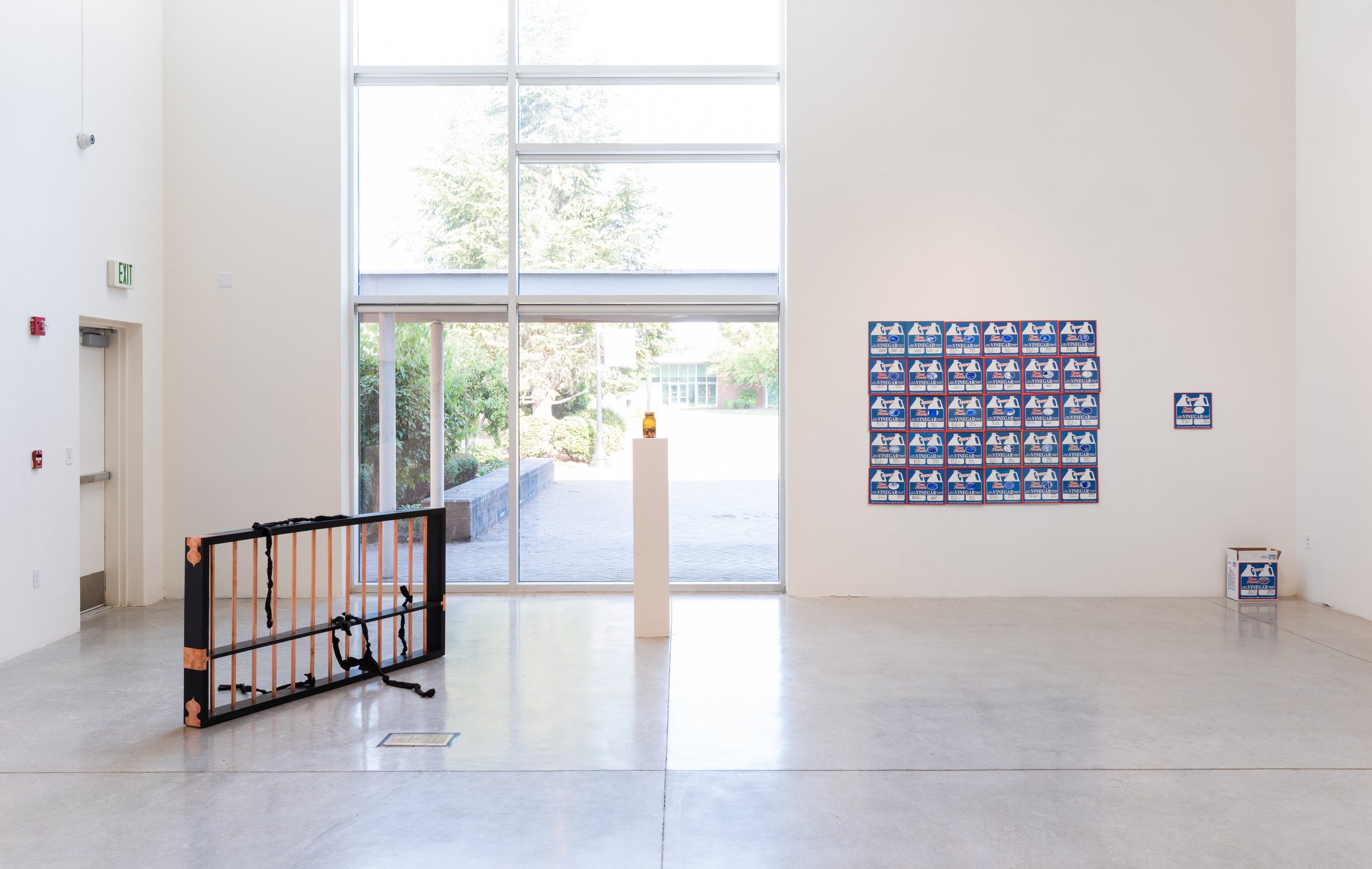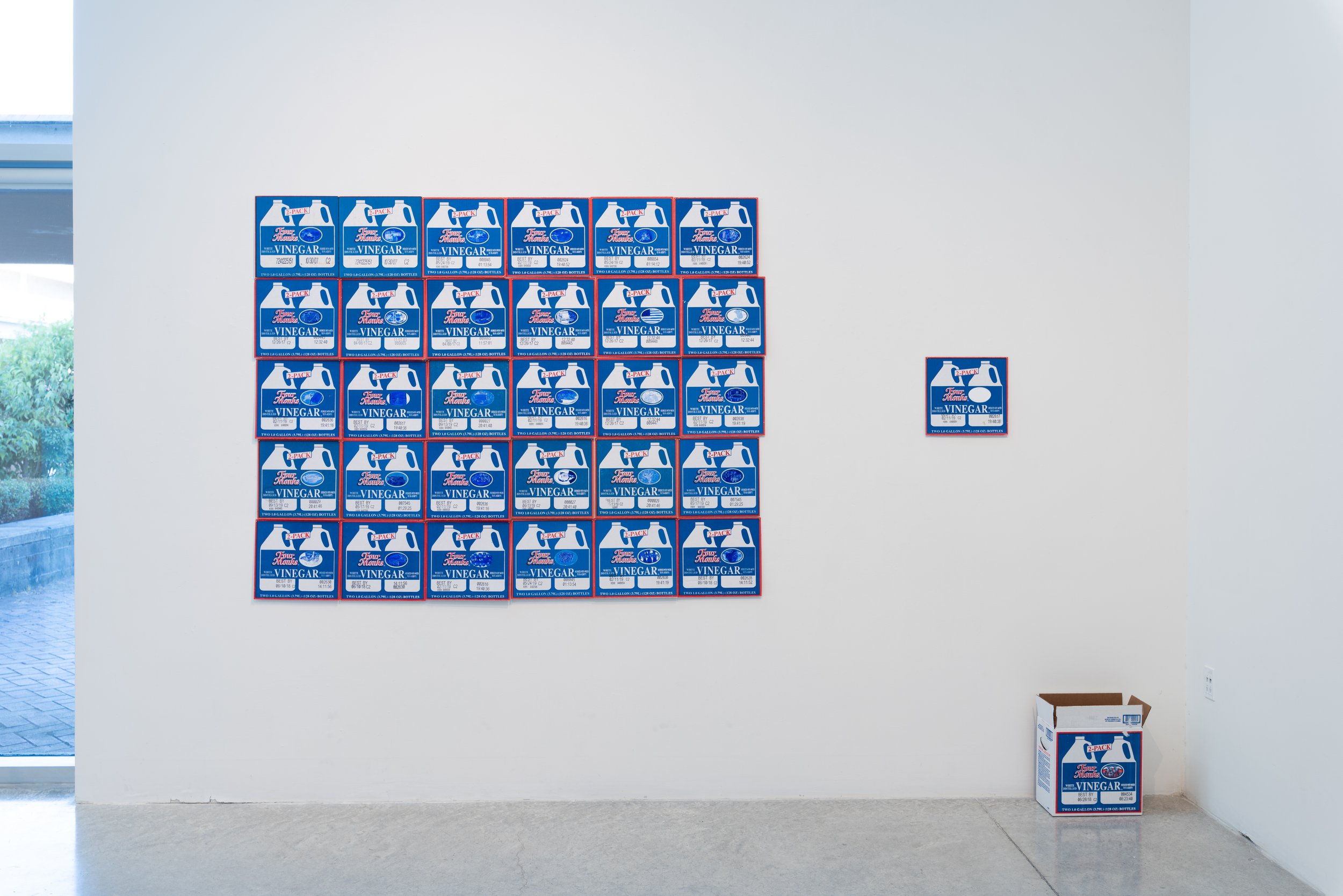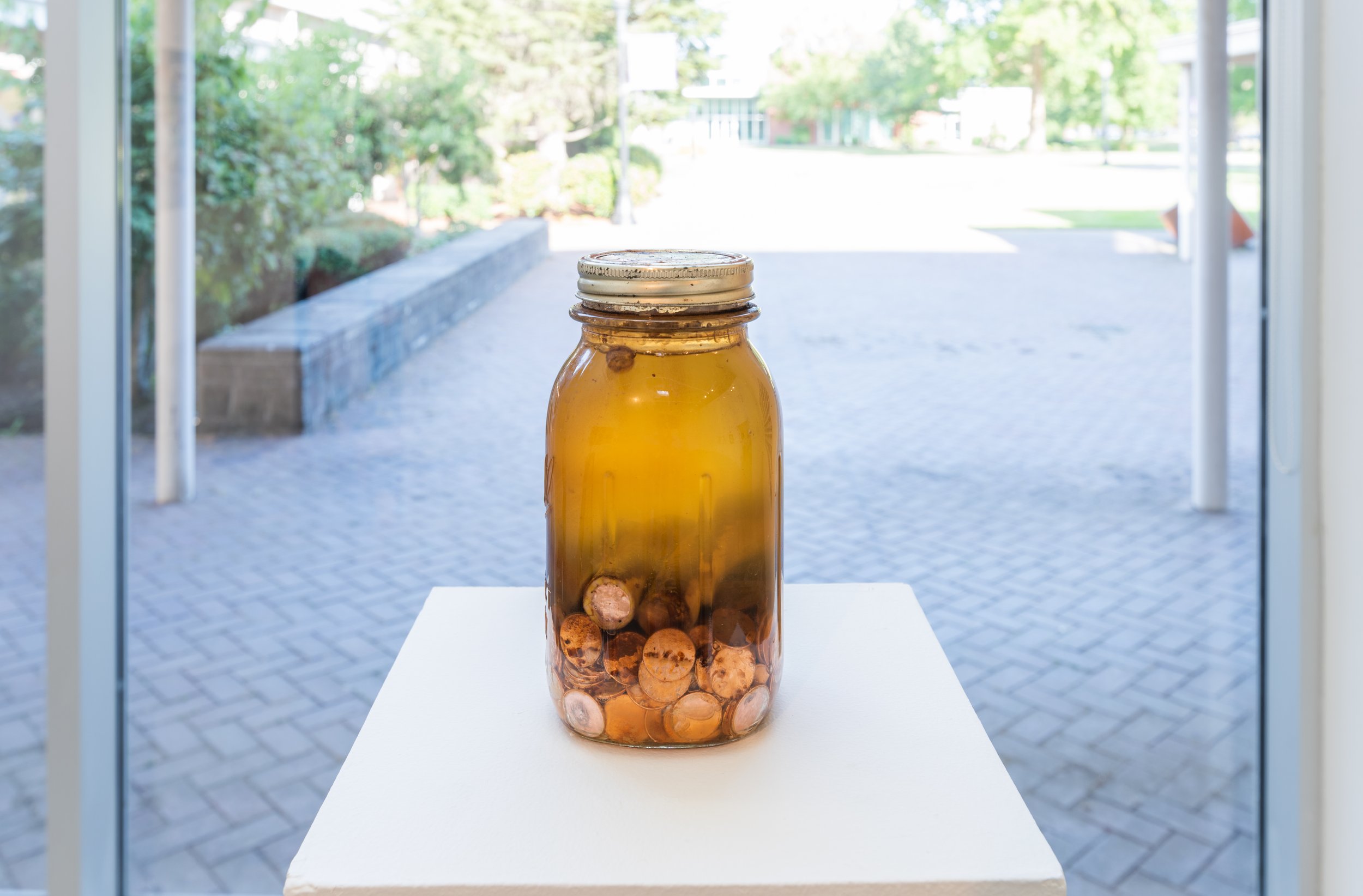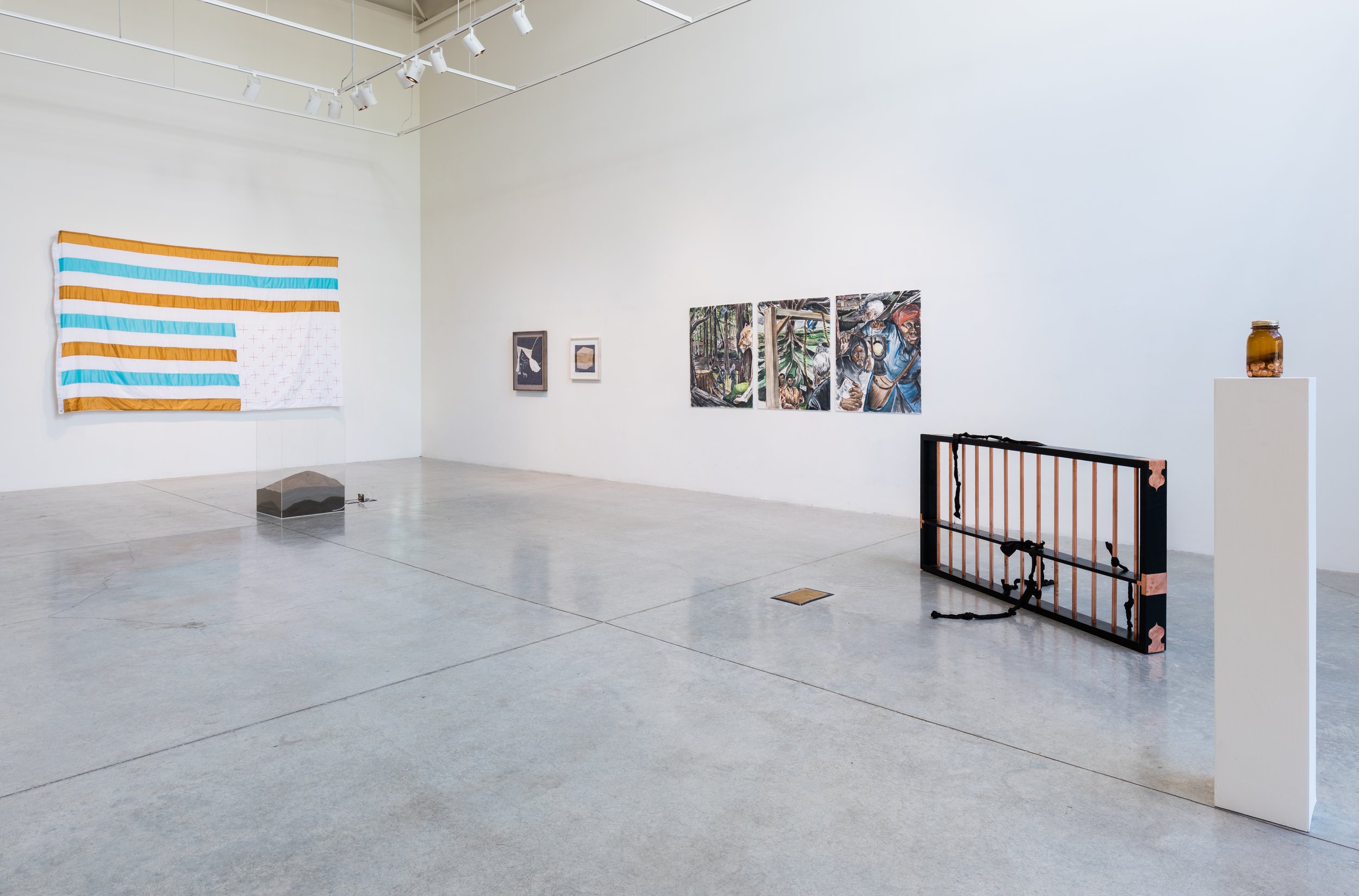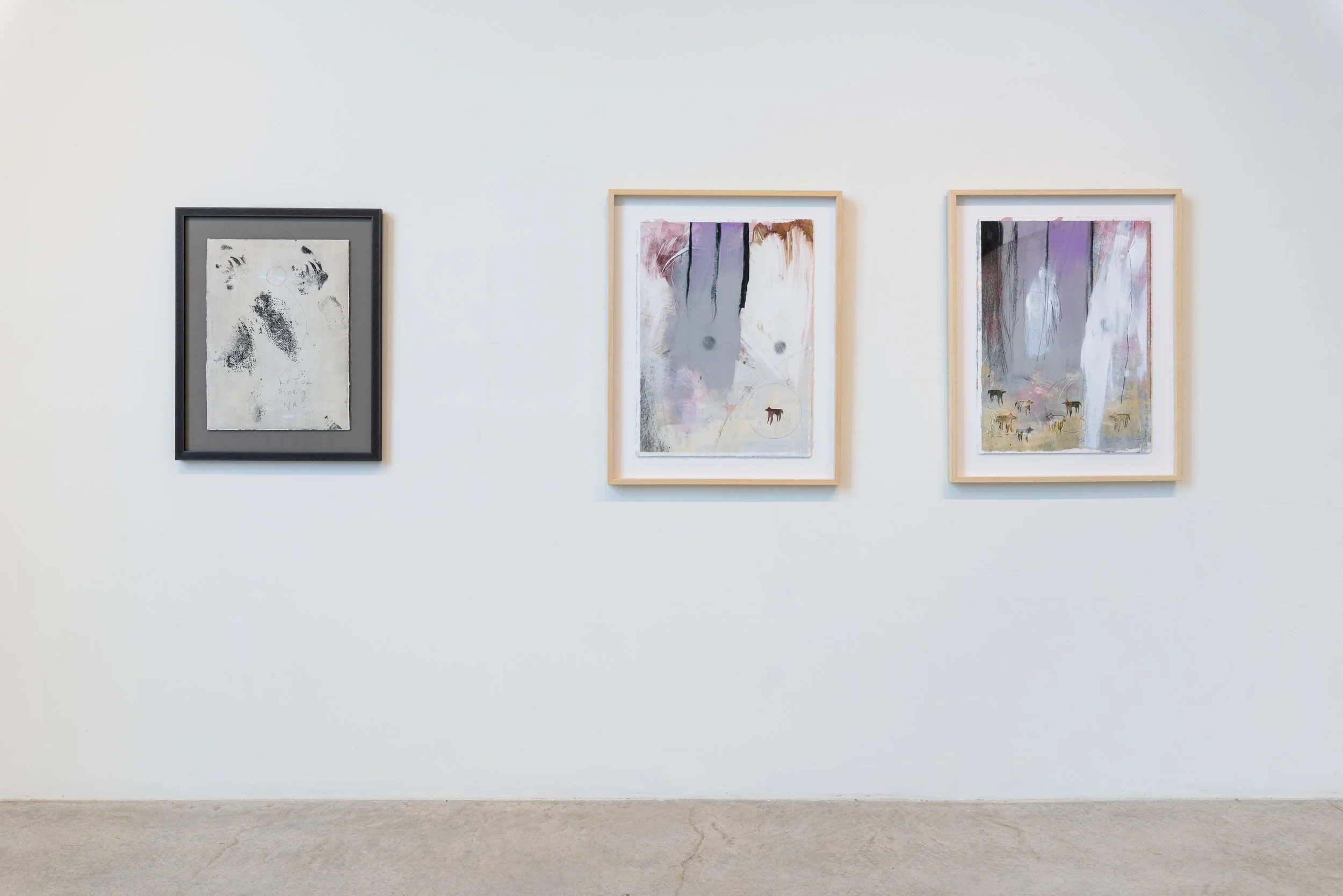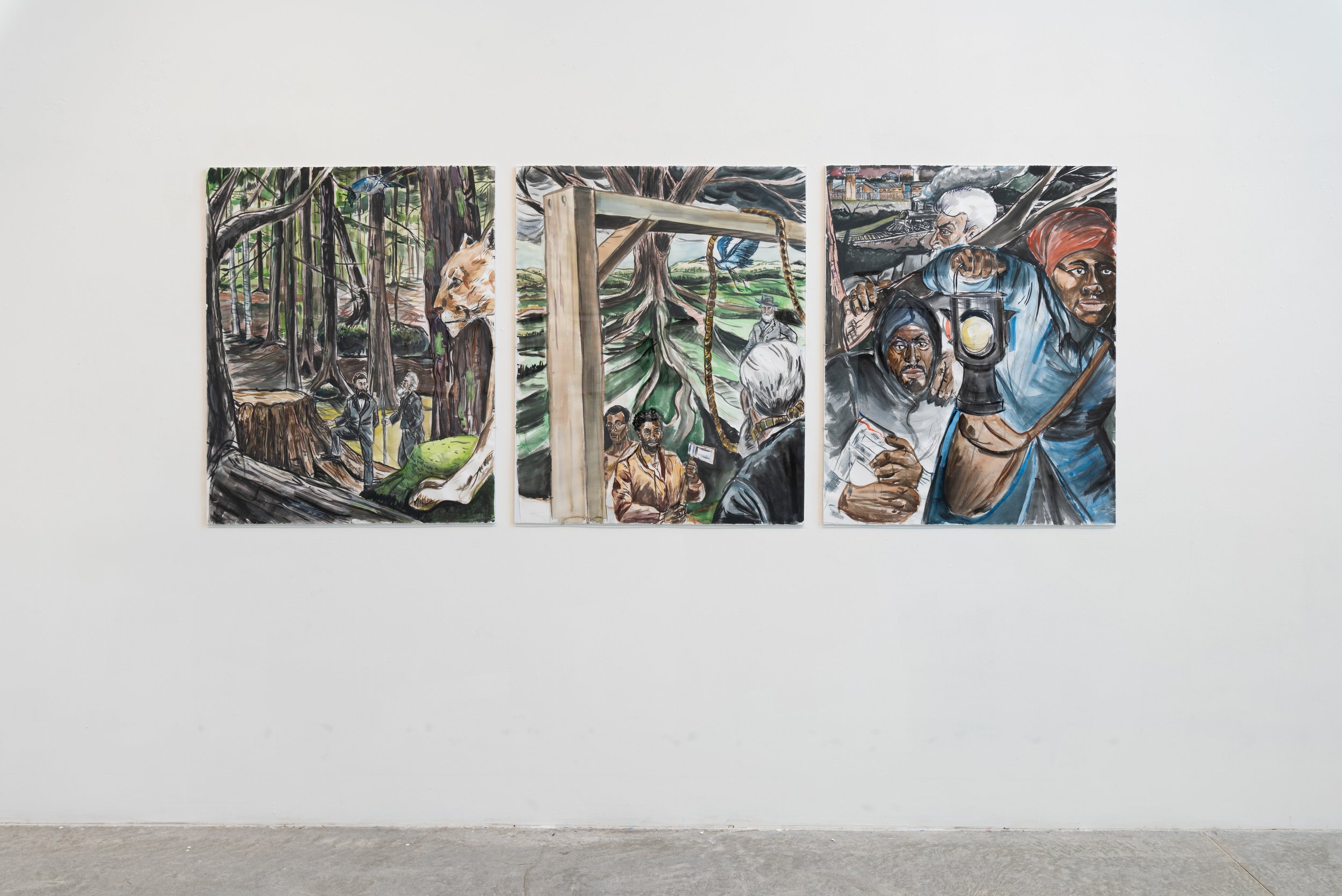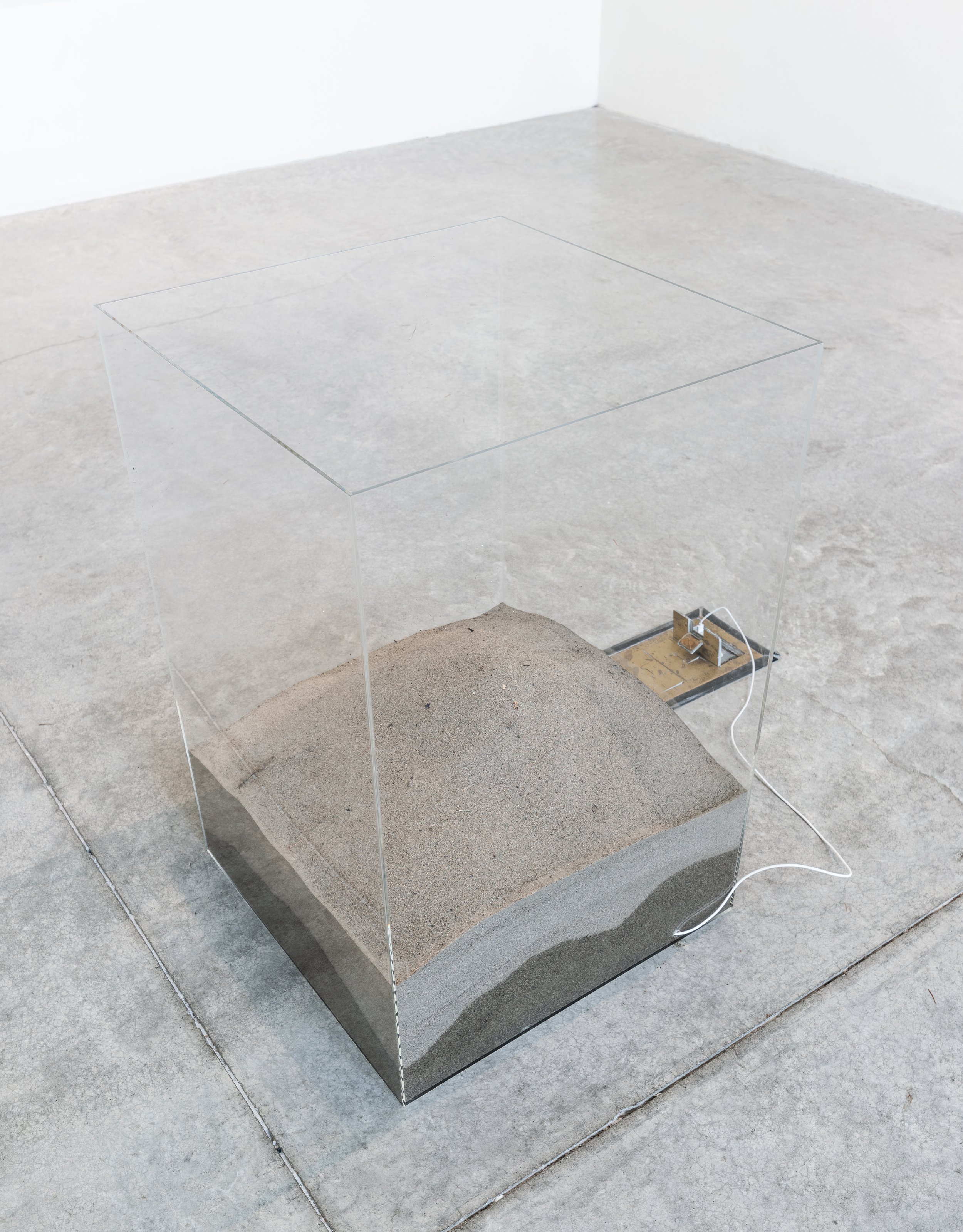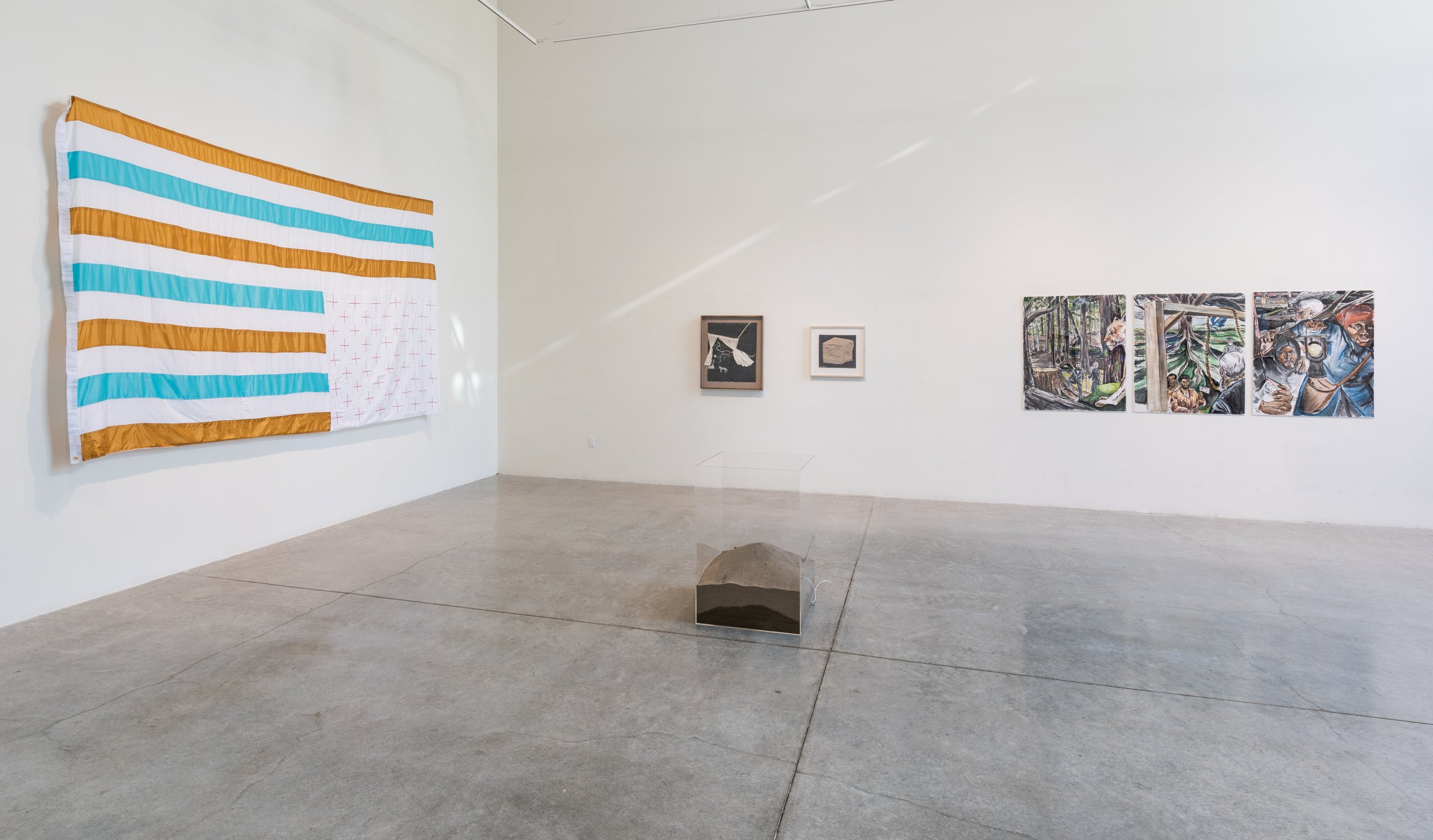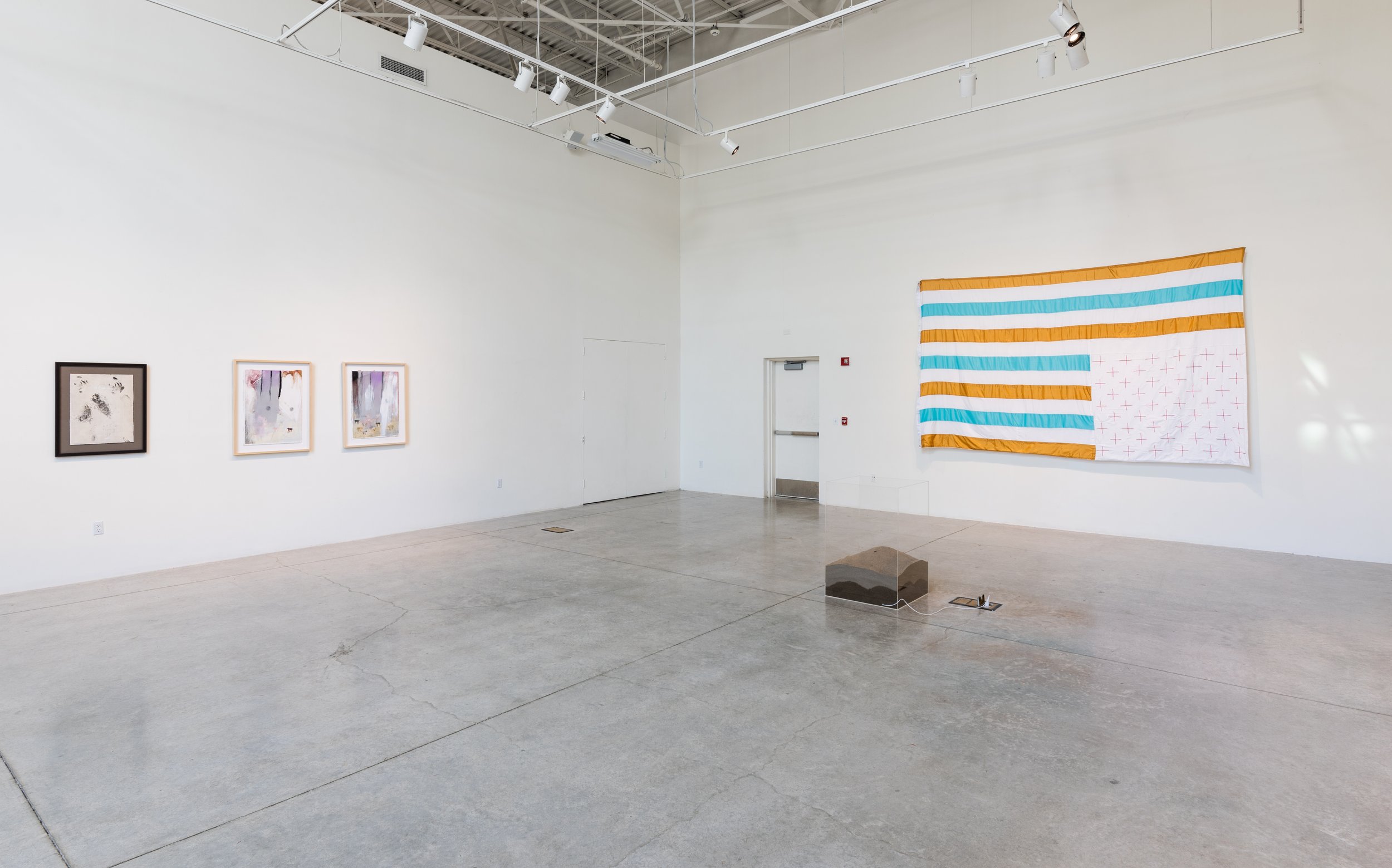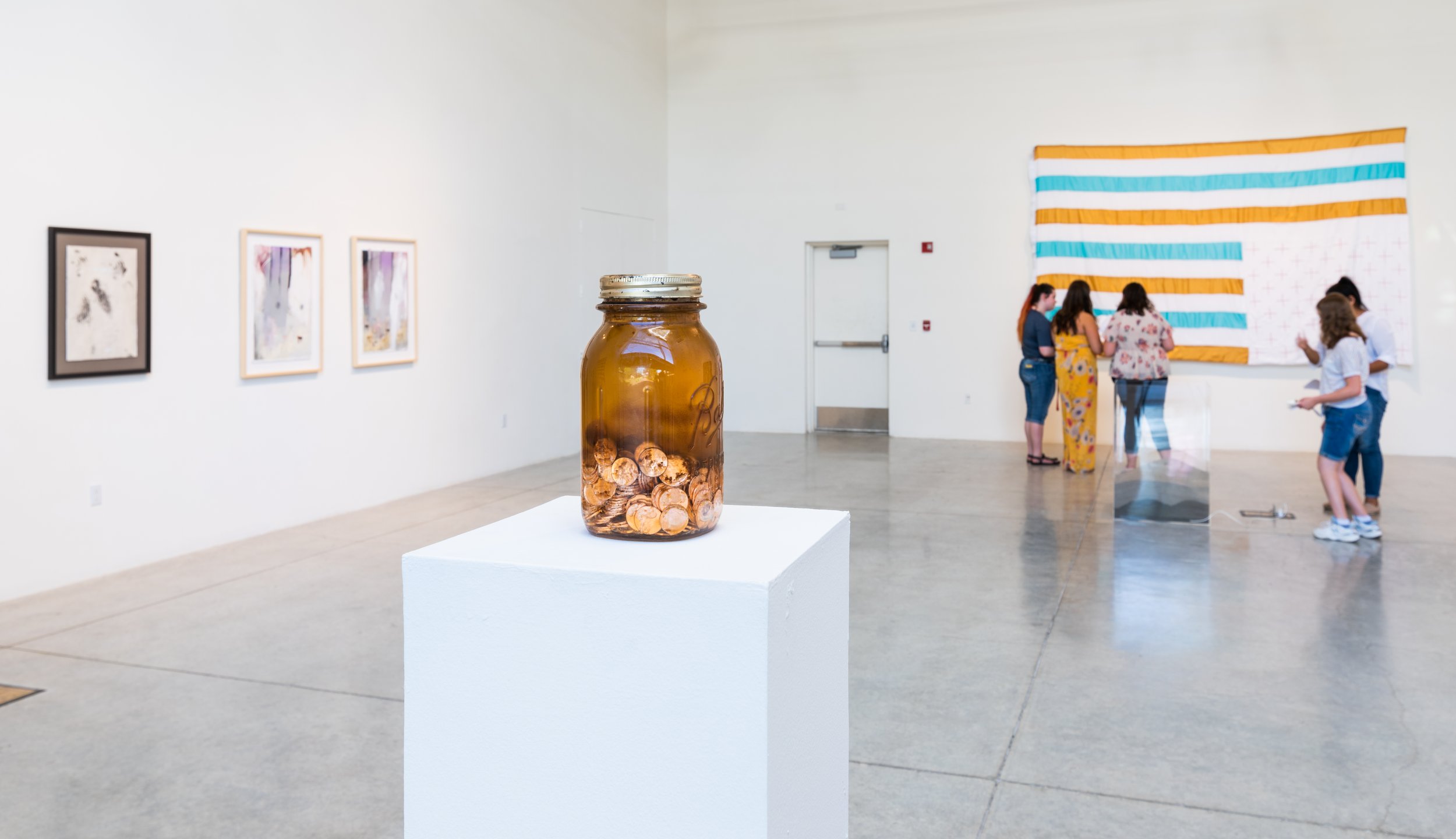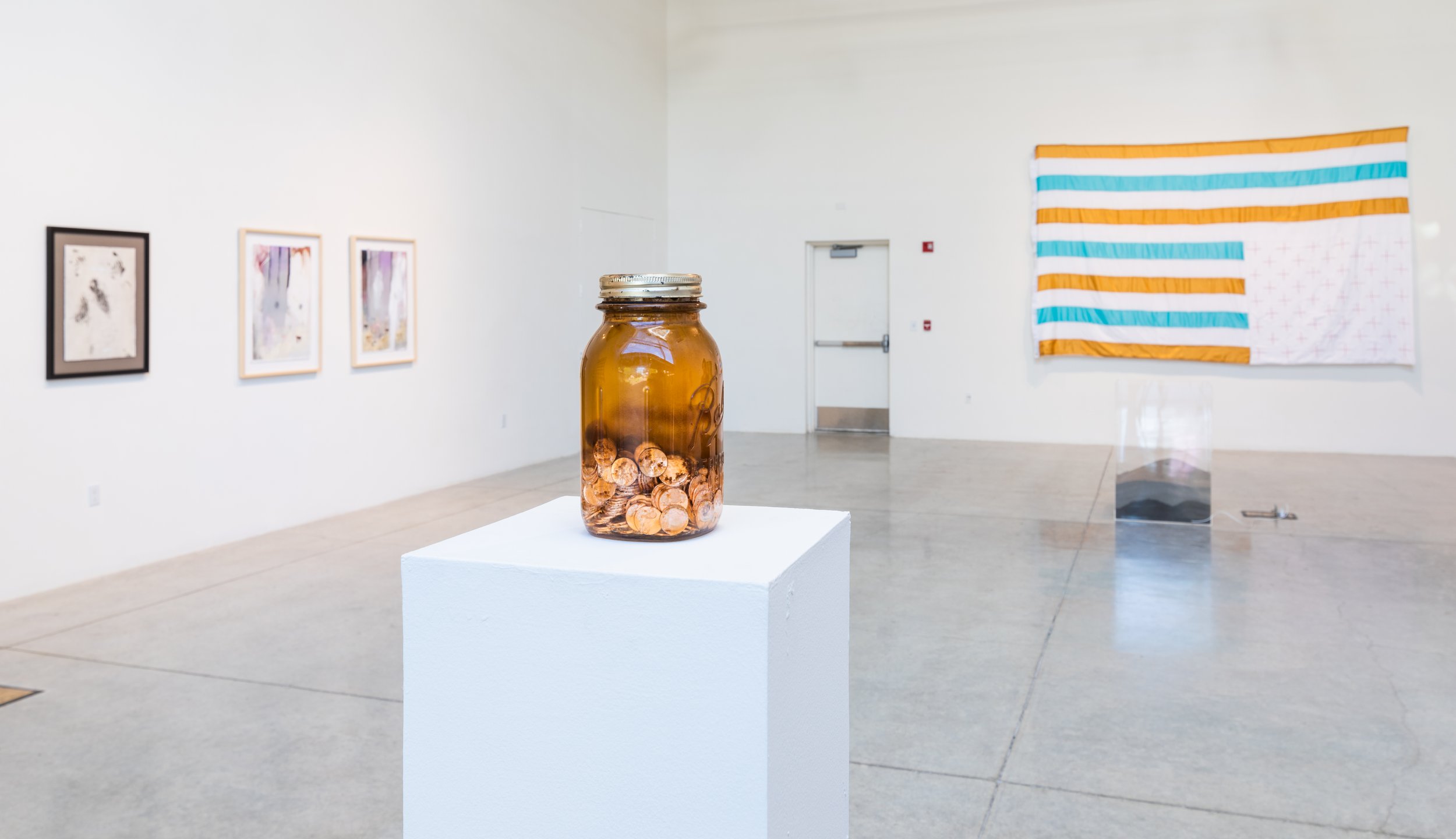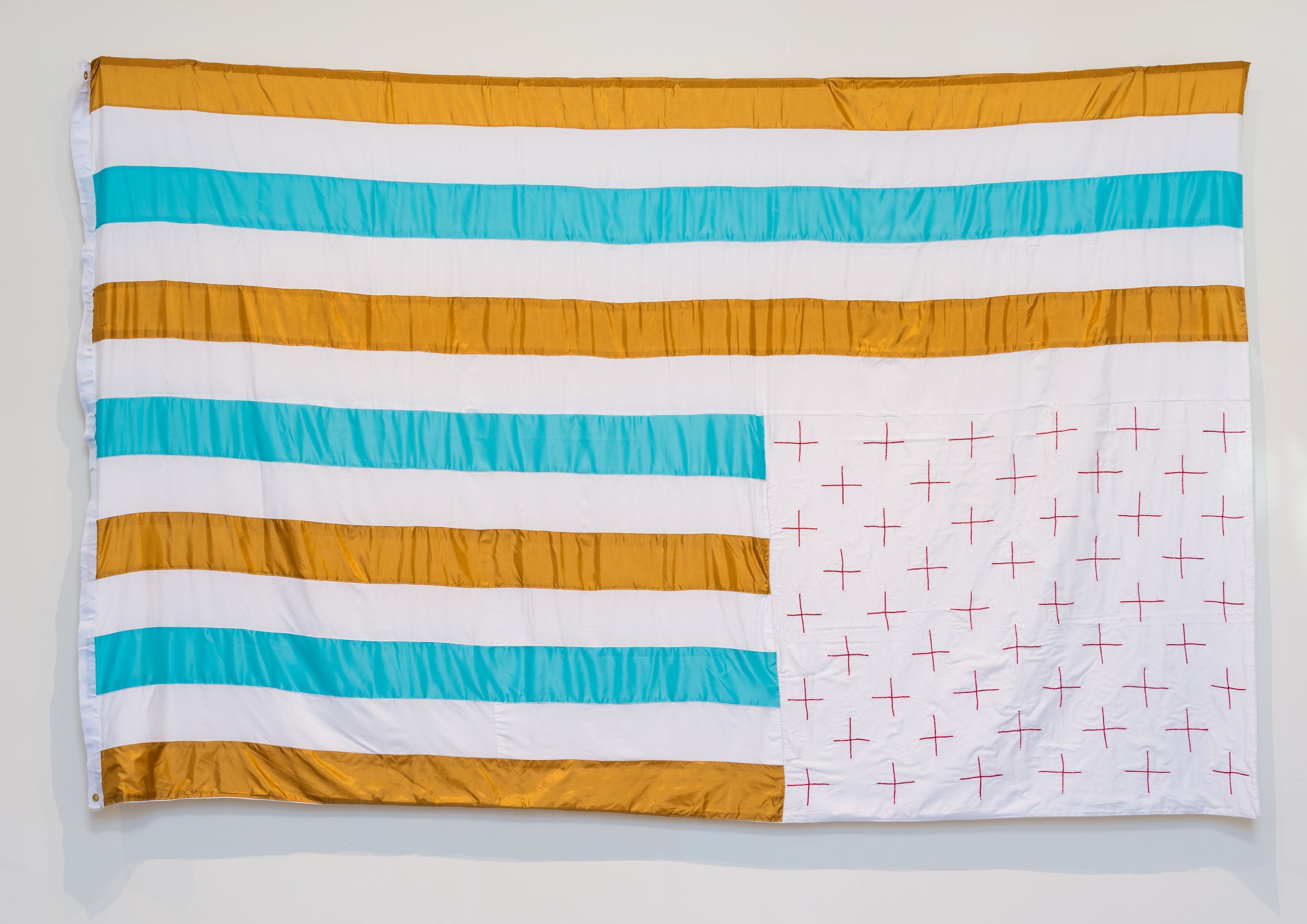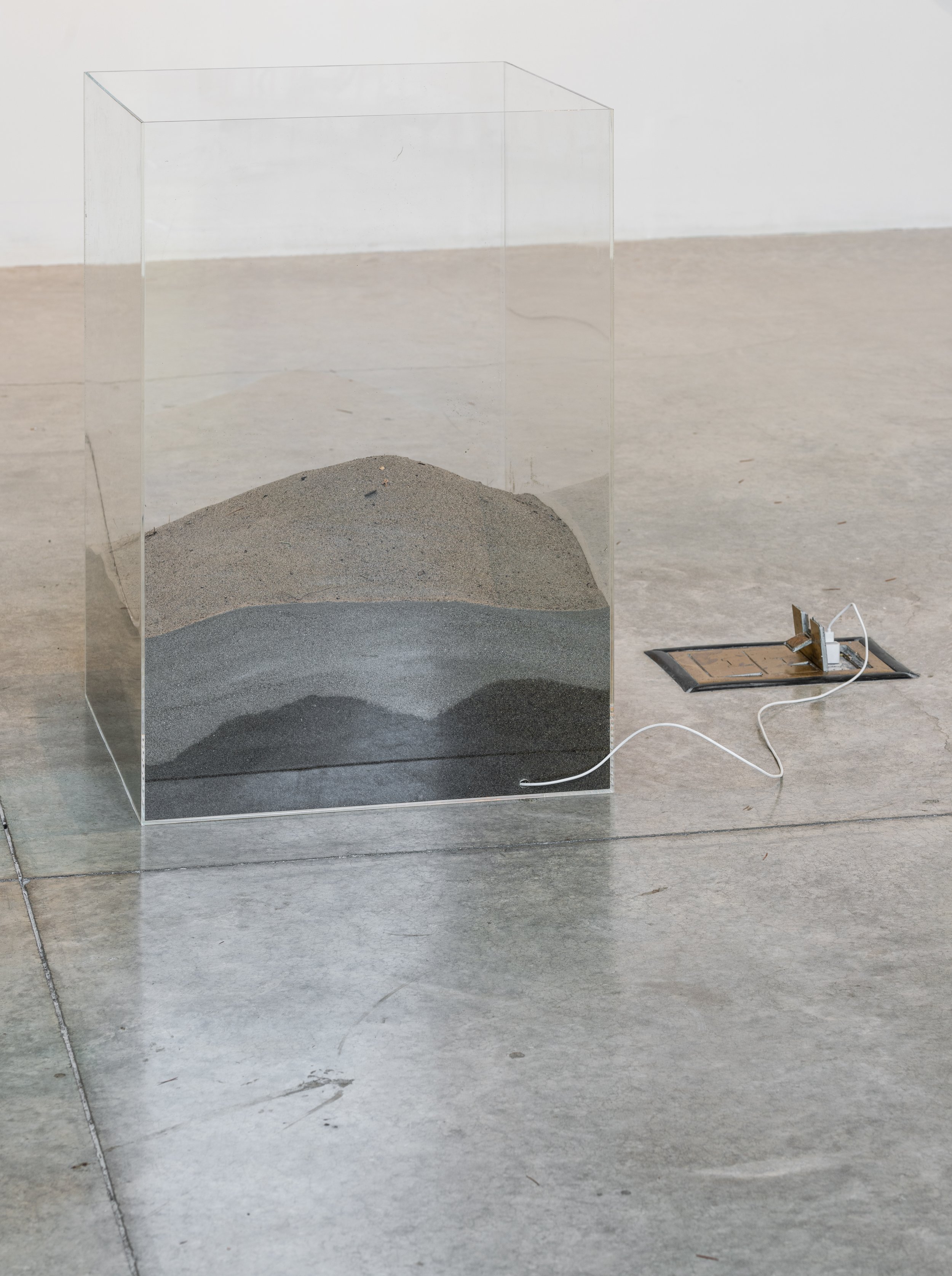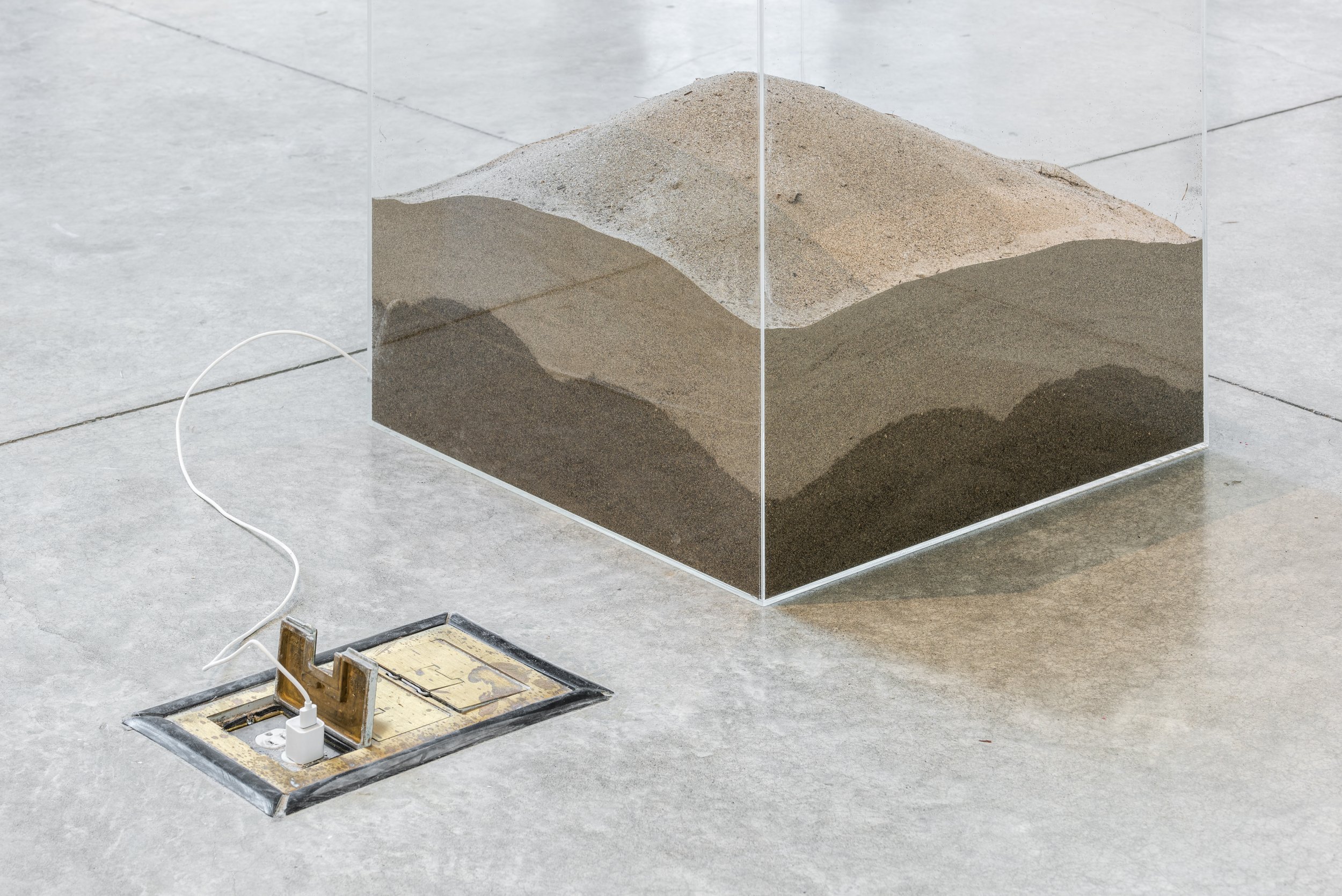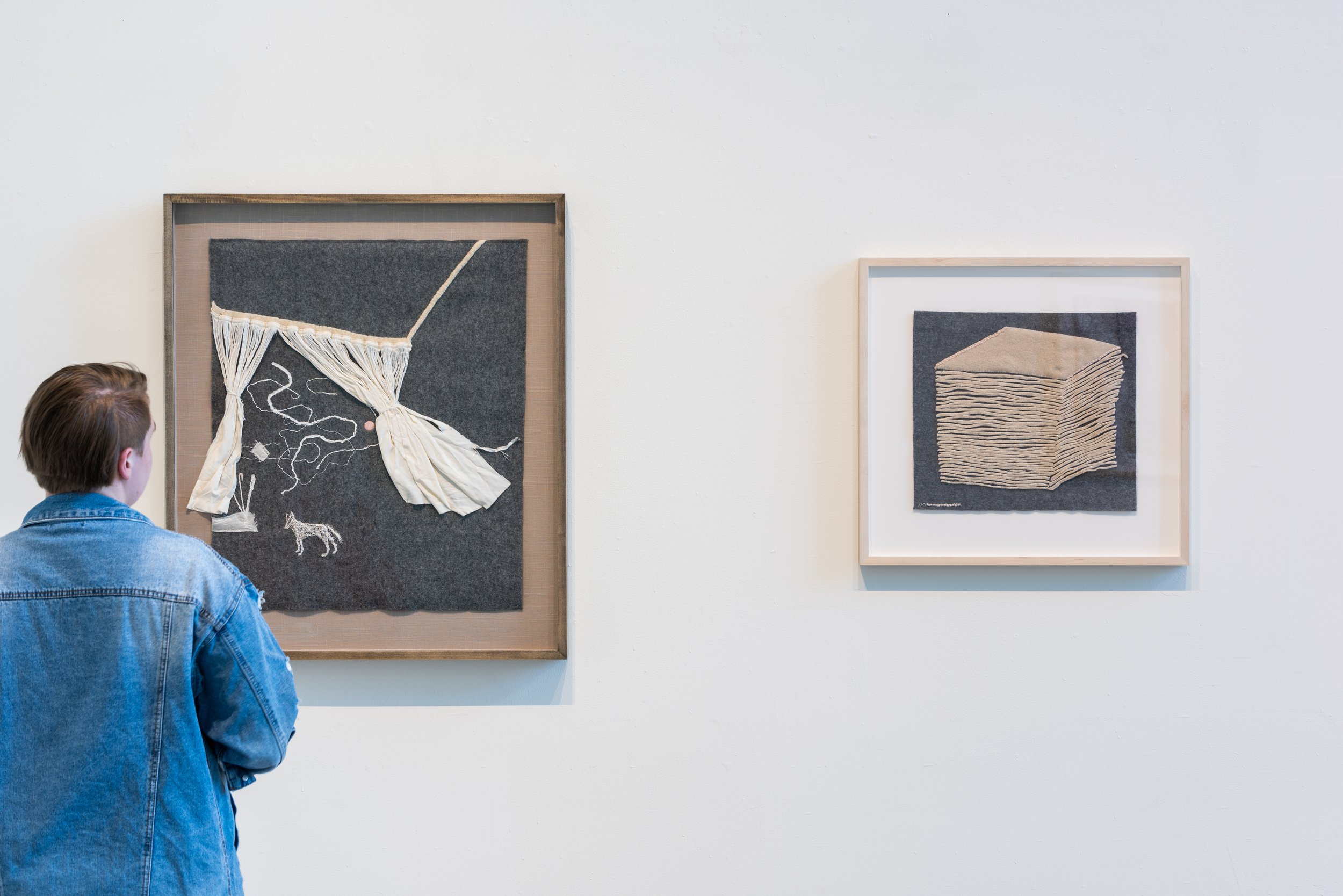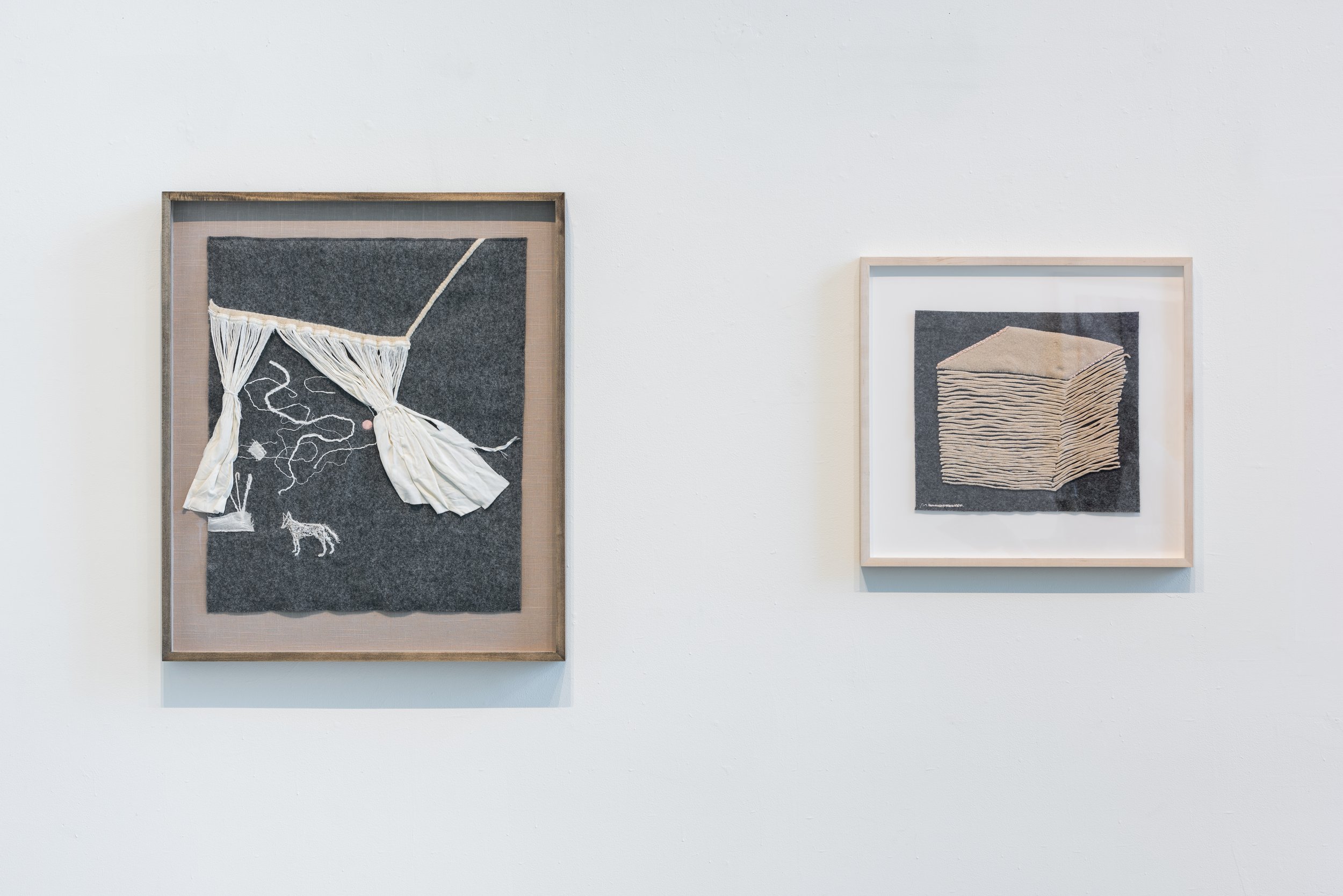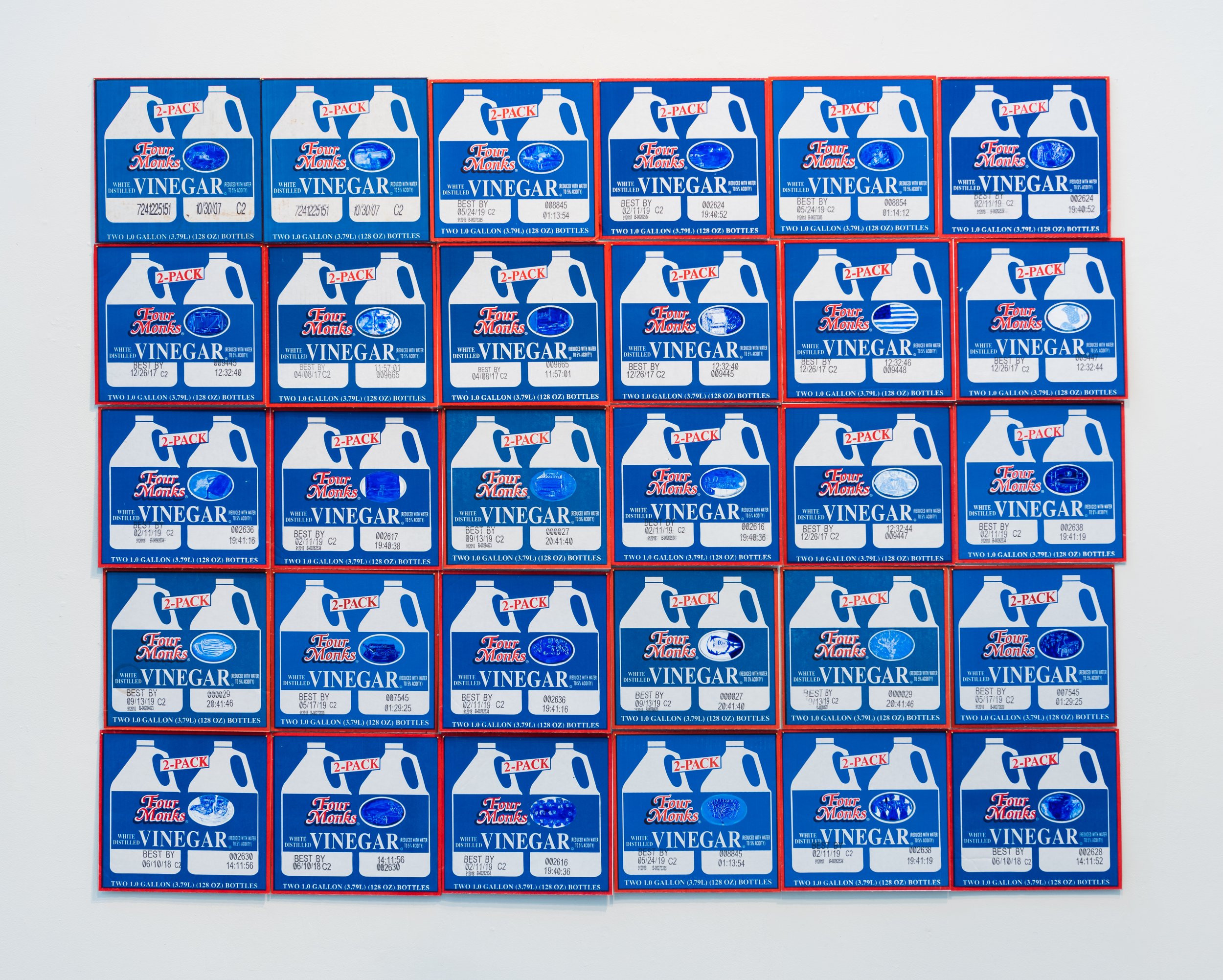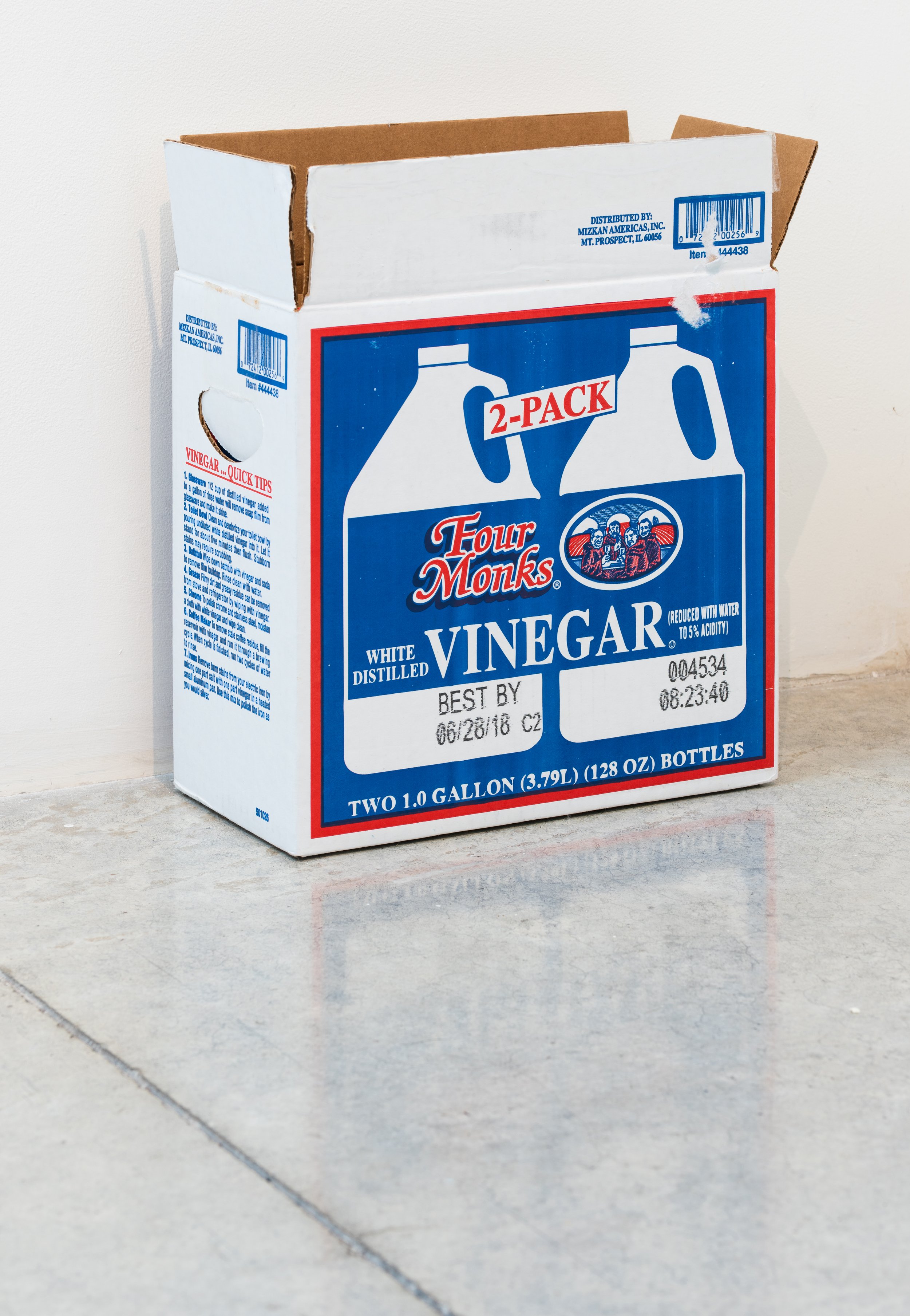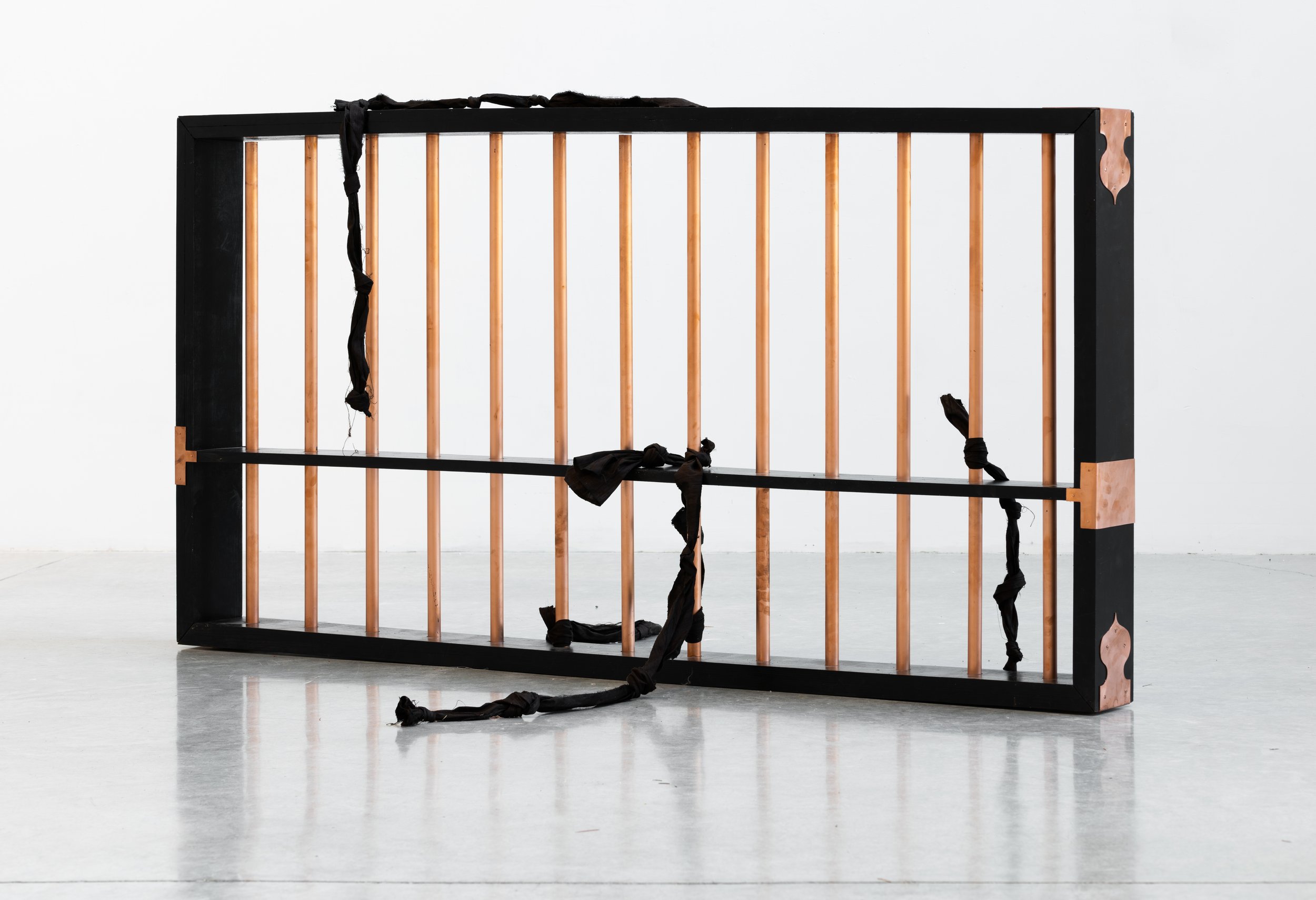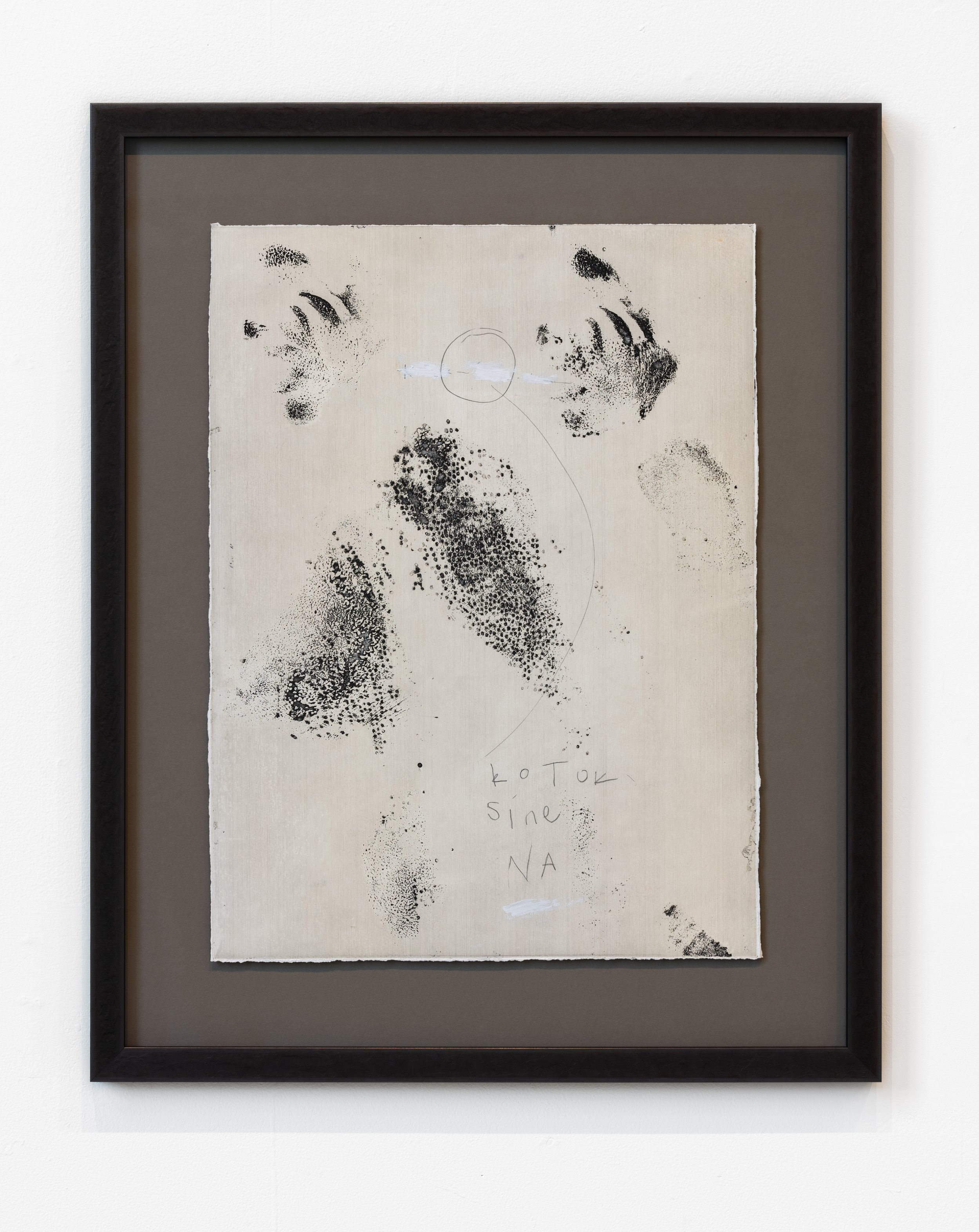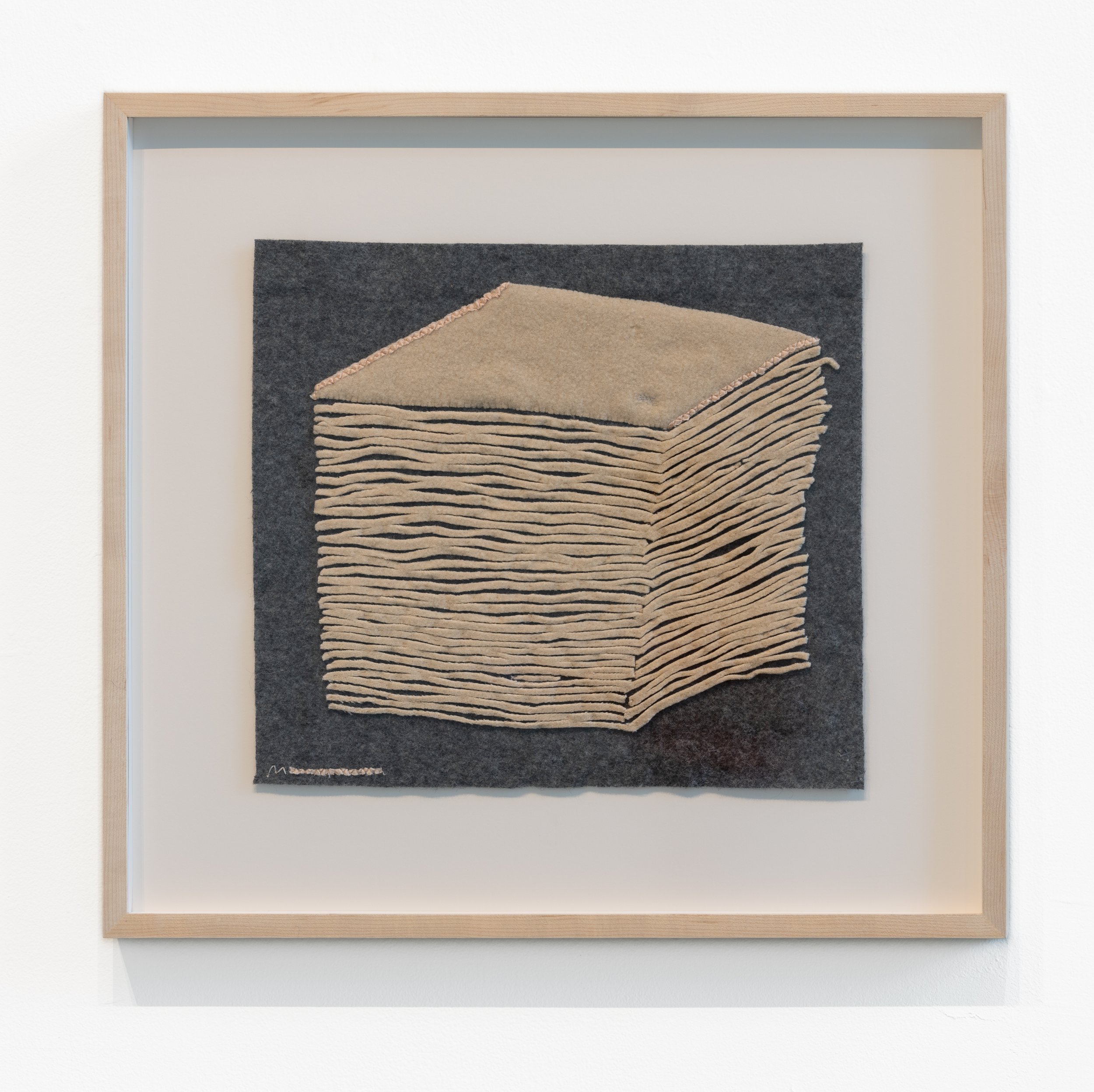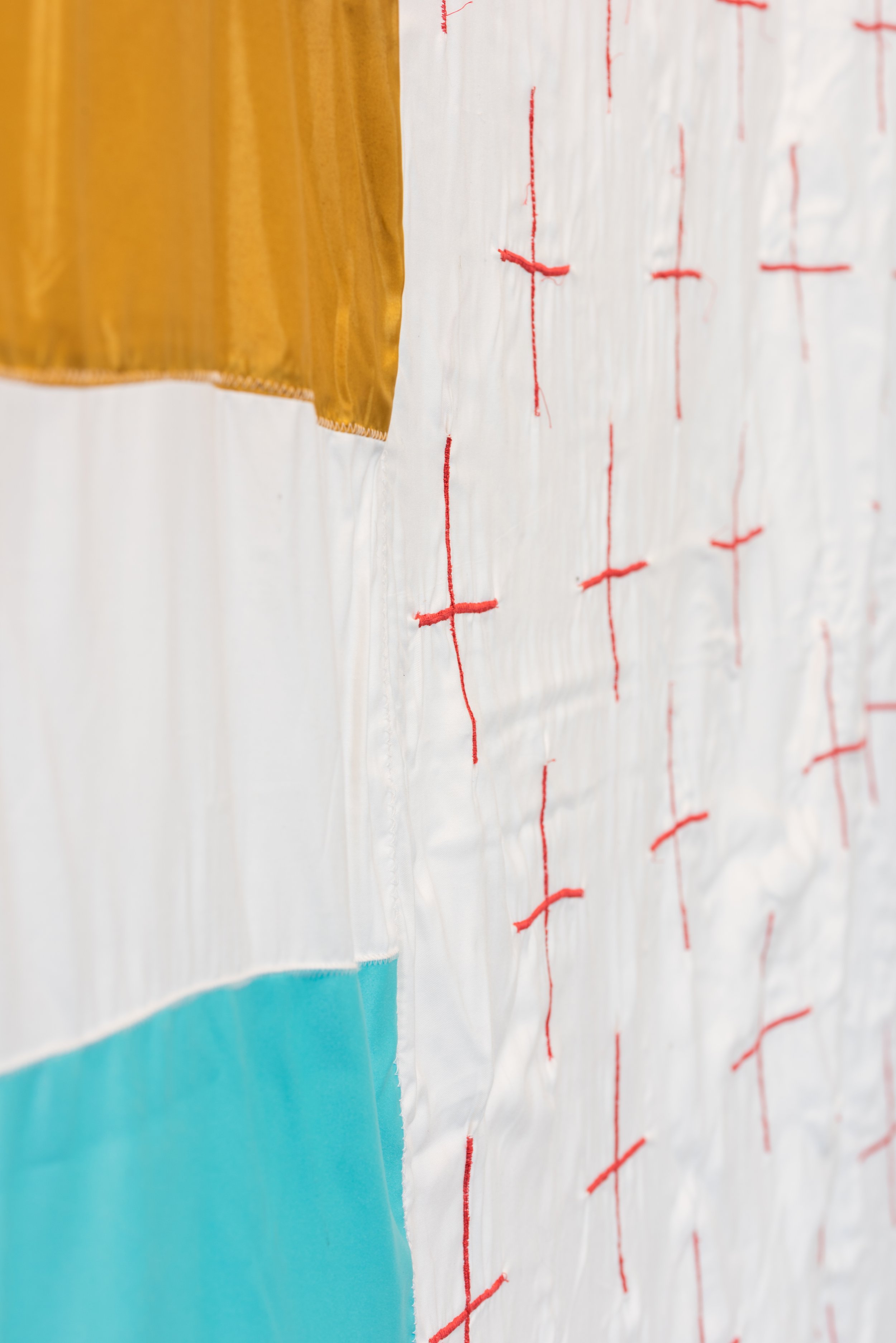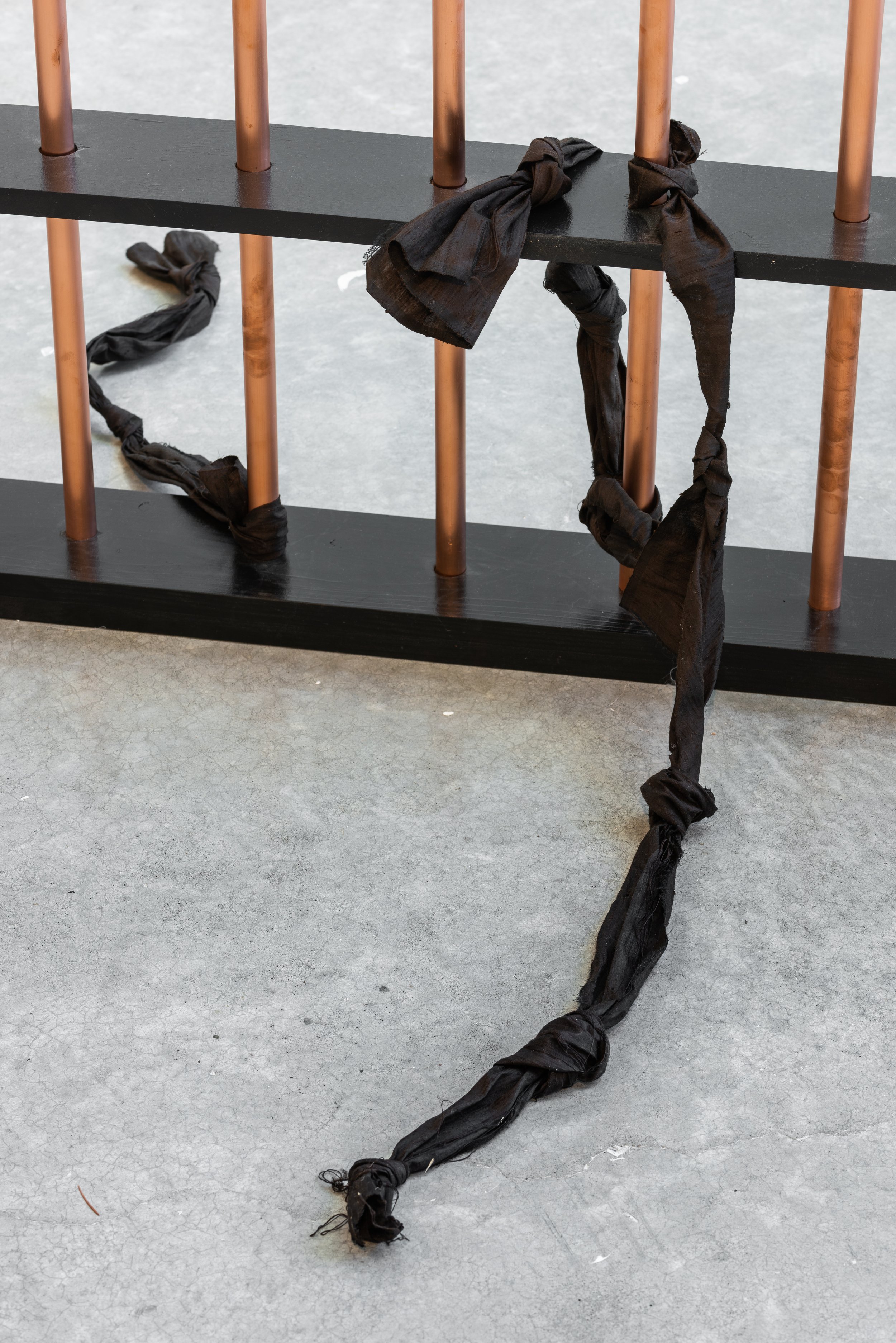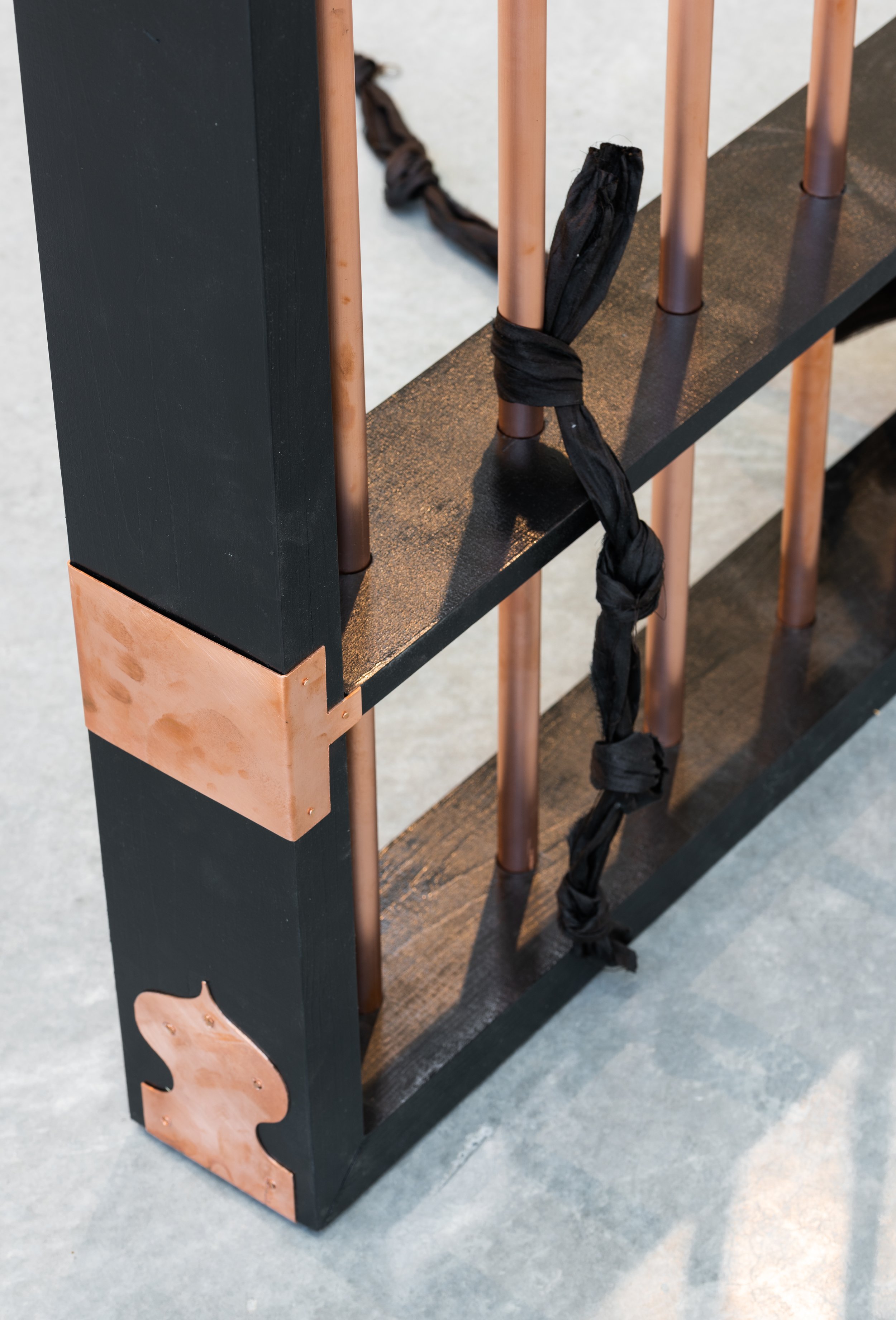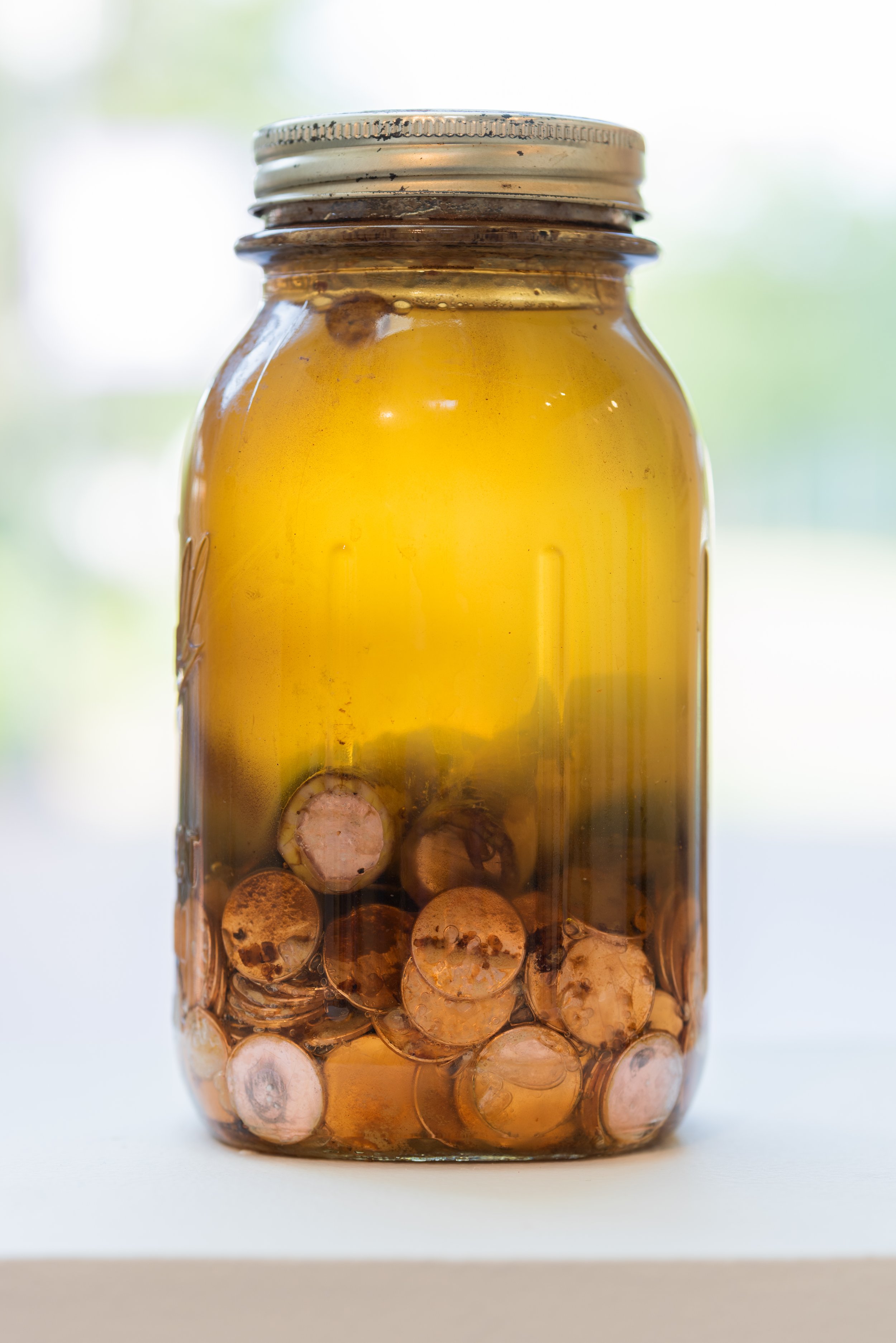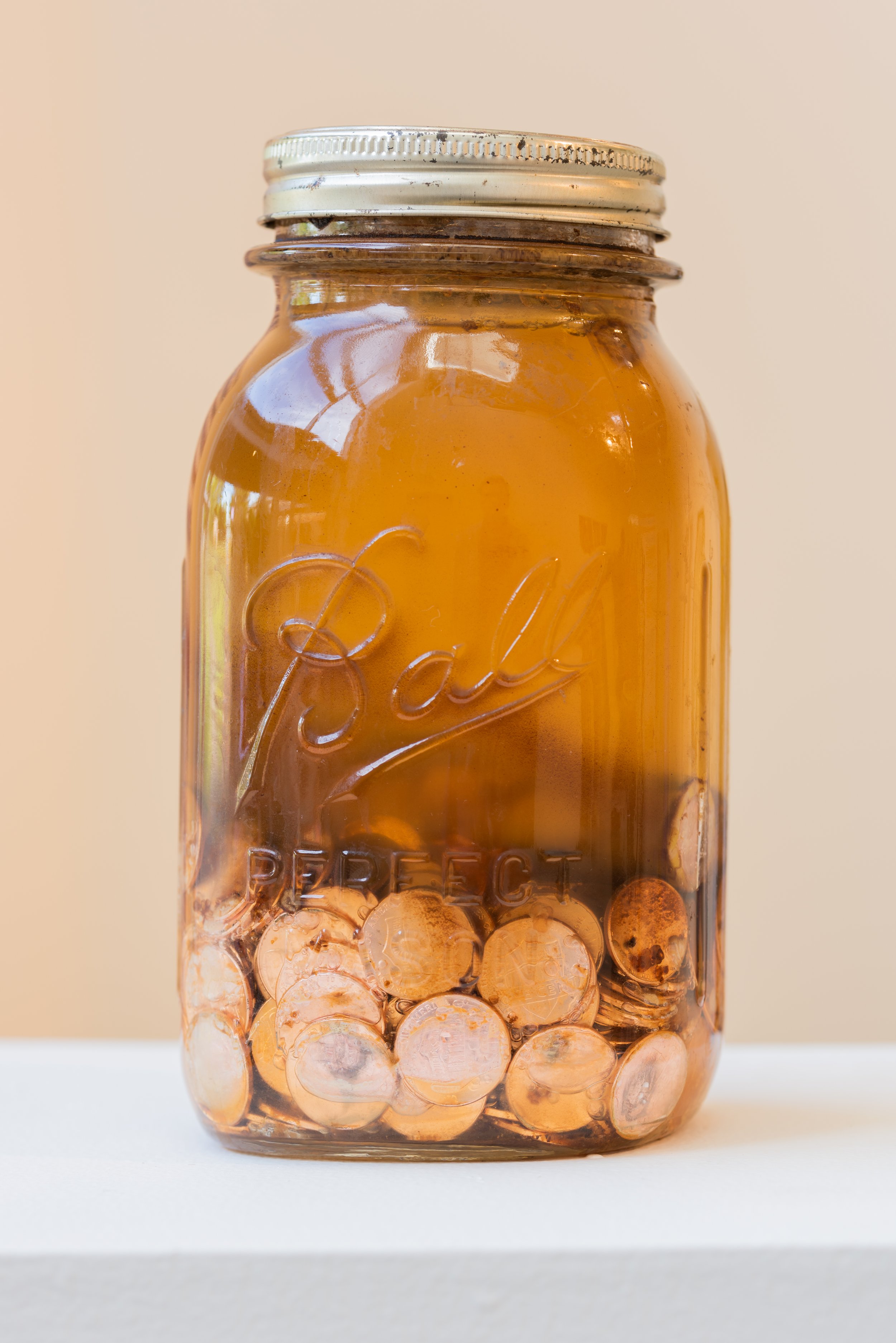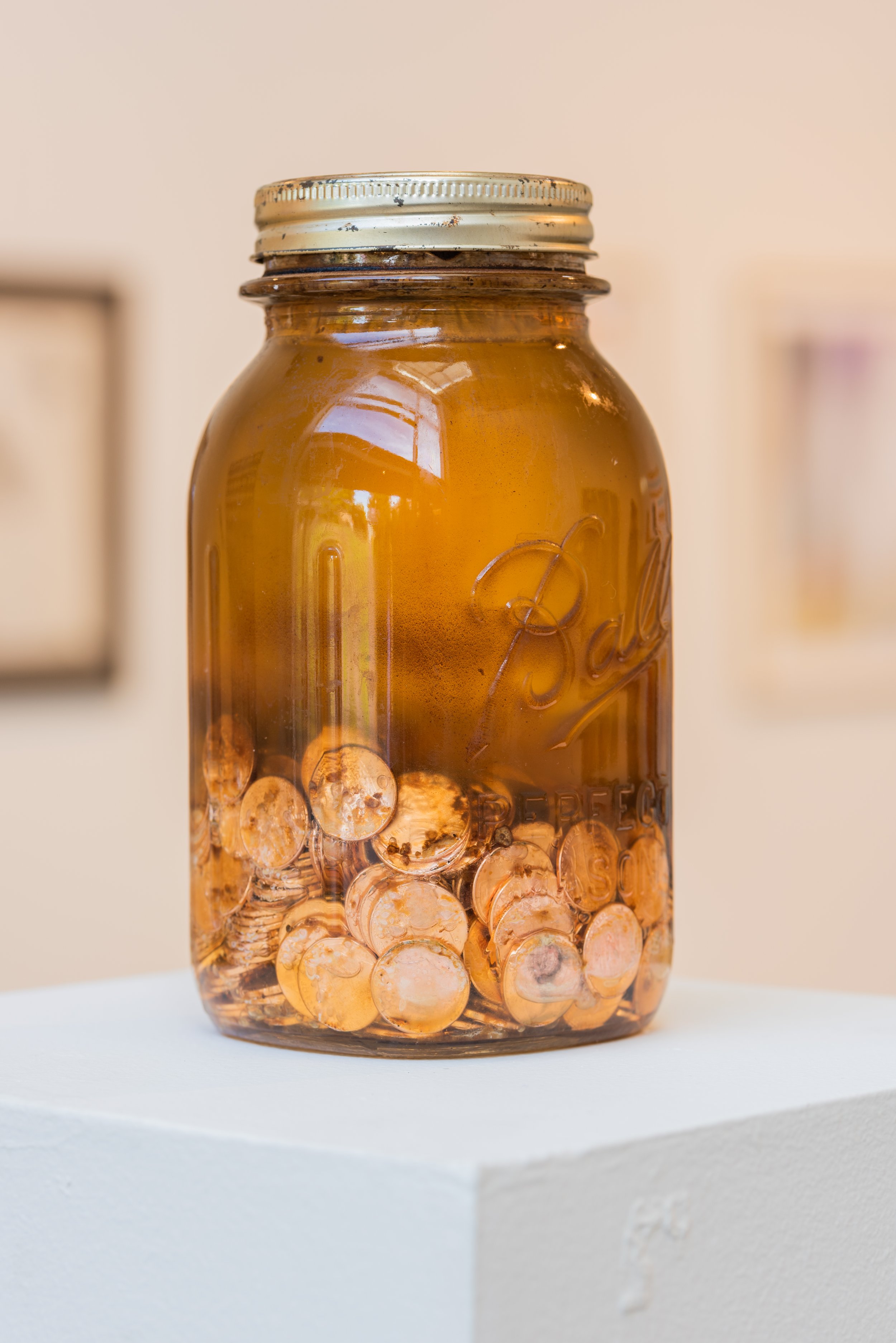America Likes Me
Demian DinéYazhi' | Daniel Duford | Ka’ila Farrell-Smith | Julie Green | sidony o’neal | Marie Watt
Exhibition Dates: August 29 – October 5, 2018
In 1974, German avant-garde artist Joseph Beuys arrived in New York City to spend three days in the René Block Gallery with a live coyote, a handful of props and a steady supply of the Wall Street Journal. The now iconic action titled I like America and America Likes Me, functioned as a ritual in which Beuys, as an outsider, could address the trauma of America’s failure to reckon with the genocide of indigenous peoples. Reflecting on the work, David Levi Strauss wrote that Beuys “engaged the coyote in a dialogue to get to 'the psychological trauma point of the United States' energy constellation; namely, the schism between Native intelligence and European mechanistic, materialistic, and positivistic values.”1
The legacy of Beuys’ practice as one of the first postmodern artists continues to complicate and influence discussions around contemporary art. In the new exhibition America Likes Me, Linfield Gallery brings together six contemporary artists whose work grapple with questions invoked by Beuys’ performance. The exhibition is a conversation about coming to terms with personal and historical narratives of identity and the legacy of oppression that is woven into our collective past as Americans. It is also about claiming space not only to talk about the past, but also to foster growth and envision new paradigm shifts.
Demian DinéYazhi's sculptural installation, nahasdzáán biłth ha'ní, references both land art, and the land’s role in rejuvenation and healing. Embedded within a plexiglass box filled with earth is an iPhone that plays two voice recordings, one by DinéYazhi and one by the artist’s mother. “Unlike the confessional spaces set up in western religion, this piece brings us back to the Land as the source of our existence and mediates a reconnection to the cosmos.” DinéYazhi writes. “Everything spoken in this audio piece is meant for the Land and no one else. It is as much about burying as it is about revealing truths to all the living energy that has existed and come to pass throughout the history of this earth.” Also on view, the work Untitled (Sovereignty) made in collaboration with Noelle V. Sosaya, takes on the complicated and colonialist symbol of the flag and literally inverts it in an act of queer and indigenous resilience.
Julie Green’s 2-pack Trauma is a series of acrylic and day–glow edged vignettes on 34 saved cardboard boxes from vinegar used by the artist over 18 years in Oregon. During a recent heat wave, Green painted this highly personal series of traumatic events in the dark cool of her basement as an attempt to identify, rank, and exorcise demons and find catharsis. Motivated, in part, by Bessel van der Kolk’s book The Body Keeps the Score, Green reflected on the the long lasting physical impact of psychological traumas and used this exercise as a ritual to purge herself of them. One blank trauma remains to the right of the grid, a looming anxiety for the future-be it political, environmental or personal, from which the artist can not yet claim to have found relief.
In her work America Likes Me, Ka’ila Farrell-Smith responds to Beuys’ directly, reflecting on the image of the coyote as a symbol of Native identity. Of the piece, Farrell-Smith writes “In my version of America Likes Me, I see myself as the coyote, working together in a pack, which is how Indigenous communities have always existed. When I am sleeping outside under the stars I hear the packs of coyotes late at night, howling, and communicating to one another. Their voices are very familiar to me.” She offers a contrast to this concept in Rugged Individualism, where the coyote-as-trickster myth becomes an America that prizes individual success over community. In this piece, the American idea of success through competition is shown as a lonely prize. Finally, in Self-Portrait with Ancestors Farrell-Smith investigates her great grandmother’s ancestral land sale/theft, which was officially signed with a sliver of her thumb print while she was not sound-of-mind. “The text in the print is my great-great grandfathers Klamath name Kotok Sine-Na, a.k.a. Palmer, who was an 1864 Klamath Treaty signer.” Farrell-Smith writes, “He is the last person to have a Klamath name, before myself, Ka’ila (G’EE LA, which means Earth and the Land). Combining this older work with my newer print-paintings, brings together two separate paths of inquiry that are rejoining in my life and studio investigations.”
Daniel Duford’s large triptych shows scenes from the life and times of John Brown, the abolitionist who led the raid on Harpers Ferry. This work raises questions about the politics of putting one’s body on the line for racial justice, an inquiry particularly poignant for white allies. While this idea is relevant to our current American moment, it also echoes the turbulence of the 1960’s. When Malcolm X spoke at an Organization of Afro-American Unity rally in 1964, he had this to say: “We need allies who are going to help us achieve a victory, not allies who are going to tell us to be nonviolent. If a white man wants to be your ally, what does he think of John Brown? You know what John Brown did? He went to war.” Duford shines a light on this controversial figure in John Brown and Henry David Thoreau Examine the Stump of the World Tree, followed by John Brown’s Vision on the Scaffold depicting the end of Brown’s life and the founding of a complicated legacy that includes the song John Brown’s Body, a rallying cry for Union Soldiers during the Civil War and the inspiration for the Battle Hymn of the Republic. Finally, The General and Supermax focuses on Harriet Tubman (whom John Brown referred to as “the General”) as she leads an unnamed prisoner away from an ominous prison facility.
Multi-disciplinary artist sidony o’neal uses sculpture and performance to draw out surfaces both linguistic and metaphysical. The two sculptural works in this exhibition are part of a series, entitled Counting Devices, that reflect the immeasurable weight placed on black bodies. untitled (abacus prototype) presents a meticulously constructed measurement tool, its beads replaced by textiles. In five on it, five dollars worth of rolled pennies have been immersed in a jar of vinegar, the wrapping dissolving over time. The piece recalls a folk remedy for keloid scarring as well as vinegars use as a skin lightening agent. With a deep interest in linguistics and languages, o’neal’s sculptures act as a kind of cipher, embedding a rich code of meaning into recognizable objects
Finally, Marie Watt’s works Companion Species Herding Threads and Dwelling Study use reclaimed wool to evoke the many cultural meanings of blankets, from a source of warmth and comfort to their spiritual function in Native ceremonies. Watt stated in a 2017 interview: “I’m not so sure about Beuys’ shamanic transformation story, but I do believe in the notion of blankets as transformative objects (which runs counter to Freud, who thought of blankets as transitional). Blankets are universal. They are intimate objects that cover, protect, insulate, nurse, celebrate, and adorn.” In the works included in America Likes Me, blankets are referenced through the materiality of the pieces, and as the subject of Dwelling Study. Watt continues: ”Despite—or perhaps owing to—their ubiquity, we often take them for granted. Blankets receive infants into the world, and shroud us when we die. I think of worn satin bindings, stains, and mended bits as being ledger-like in the way they register dreams, child’s play, intimacy, war, and celebratory moments in life.”
ABOUT THE ARTISTS
Demian DinéYazhi´ (born 1983) is an Indigenous Diné transdisciplinary artist born to the clans Naasht'ézhí Tábąąhá (Zuni Clan Water's Edge) and Tódích'íí'nii (Bitter Water). Growing up in the colonized border town of Gallup, New Mexico, the evolution of DinéYazhi´'s work has been influenced by their ancestral ties to traditional Diné culture and ceremony, matrilineal upbringing, the sacredness of land, and the importance of intergenerational knowledge. Through research, mining community archives, and social collaboration and activism, DinéYazhi´ highlights the intersections of Radical Indigenous Queer Feminist identity and political ideology while challenging the white noise of the contemporary art movement. They have recently exhibited at Whitney Museum of American Art (2018), Henry Art Gallery (2018), Pioneer Works (2018), CANADA, NY (2017), and Douglas F. Cooley Memorial Art Gallery (2017). DinéYazhi´ is the founder of the Indigenous artist/activist initiative, R.I.S.E.: Radical Indigenous Survivance & Empowerment. DinéYazhi´ also serves as co editor of Locusts: A Post-Queer Nation Zine. They are the recipient of the Henry Art Museum's Brink Award (2017) and a Hallie Ford Fellow in the Visual Arts (2018). @heterogeneoushomosexual
Daniel Duford is an artist, writer and teacher. He is a Hallie Ford Fellow, a MacDowell Fellow and a recipient of an Art Matters grant. He is Executive Director of The Ground Beneath Us an artist residency and intensive summer class based on visual narrative and social justice in Waterford, VA. His work has been shown at MASS MoCA, Contemporary Craft Museum and Boise Art Museum. His writing has appeared in Artweek, Parabola and Ceramics: Art and Perception.
Ka'ila Farrell-Smith is a contemporary Klamath Modoc visual artist based in Modoc Point, Oregon. The conceptual framework of her practice focuses on channeling research through a creative flow of experimentation and artistic playfulness rooted in Indigenous aesthetics and abstract formalism. Utilizing painting and traditional Indigenous art practices, her work explores space in-between the Indigenous and western paradigms. Ka’ila displays work in the form of paintings, objects, and self curated installations.
Ka’ila is a Co-director for Signal Fire artist residency program. Her work has been exhibited at Out of Sight, Museum of Northwest Art, Tacoma Art Museum, WA; Missoula Art Museum, MT and Medici Fortress, Cortona, Italy; and in Oregon she has work in the permanent collection of the Jordan Schnitzer Museum of Art and Portland Art Museum. Ka’ila has recently been selected to attend artist residencies at Caldera, Djerassi, Ucross, Playa, Institute of American Indian Arts, and Crow's Shadow. Ka'ila Farrell-Smith received a BFA in Painting from Pacific Northwest College of Art and an MFA in Contemporary Art Practices Studio from Portland State University.
Julie Green (b. 1961 in Yokosuka, Japan) wanted to be a stewardess until age four, but became a painter instead. Green’s work has been featured in The New York Times, a Whole Foods mini documentary, PBS, Ceramics Monthly, Gastronomica, and 7th edition of A World of Art published by Prentice Hall. She has exhibited widely in the United States and internationally. Half of each year, usually in winter months, she works on The Last Supper, an ongoing project about capital punishment in the United States. Green lives in the Willamette Valley and is a professor at Oregon State University.
Awarded a 2017 Hallie Ford Fellowship in the Visual Arts from The Ford Family Foundation, Green also received a 2011 Joan Mitchell Foundation Painters and Sculptors Grant, the 2015 ArtPrize 3-D Juried Award, a 2016 Fellowship and a 2017 Career Opportunity Grant from the Oregon Arts Commission. A selection of Green's My New Blue Friends paintings exhibited in the Governor's Office in Salem in summer 2016, and she was included in Portland2016: A Biennial of Contemporary Art, curated by Michelle Grabner and presented by Disjecta Contemporary Art Center. The most recent iteration of The Last Supper, then numbering 700 plates, exhibited at Texas State University in San Marcos, Texas.
sidony o’neal is a writer and artist from South Sacramento, CA. Their writing has appeared in The Capilano Review, Women and Performance: a journal of feminist theory, Passages North, and SPOOK magazine among other publications. sidony has held artist residencies at Banff Centre, Portland Institute of Contemporary Art, Arteles Center, and S1 Gallery. sidony currently teaches in the department of Music & Sonic Arts at Portland Community College.
Marie Watt (b. 1967) is an American artist. Her work draws from history, biography, Iroquois protofeminism, and Indigenous principles, and addresses the interaction of the arc of history with the intimacy of memory.
Blankets, one of her primary materials, are everyday objects that can carry extraordinary histories of use. In her tribe (Ms. Watt is an enrolled member of the Seneca Nation of Indians) and other Indigenous communities, blankets are given away to honor those who are witness to important life events.
Ms. Watt holds an MFA in Painting and Printmaking from Yale University, attended Willamette University and the Institute of American Indian Arts, and in 2016 was awarded an Honorary Doctorate from Willamette University. Among other residencies, she has attended the Skowhegan School of Painting and Sculpture; and received fellowships from the Joan Mitchell Foundation and the Anonymous Was a Woman Foundation.
Ms. Watt lives in Portland, Oregon, with her husband, the graphic designer Adam McIsaac, and her daughters, Maxine and Evelyn. She exhibits internationally, and is represented in Portland by PDX Contemporary Art, and in Seattle by Greg Kucera Gallery.


